9 - Neuro-ophthalmology
Editors: Tasman, William; Jaeger, Edward A.
Title: Wills Eye Hospital Atlas of Clinical Ophthalmology , The, 2nd Edition
Copyright 2001 Lippincott Williams & Wilkins
> Table of Contents > Chapter 9 - Neuro-ophthalmology
function show_scrollbar() {}
Chapter 9
Neuro-ophthalmology
Peter J. Savino
Helen V. Danesh-Meyer
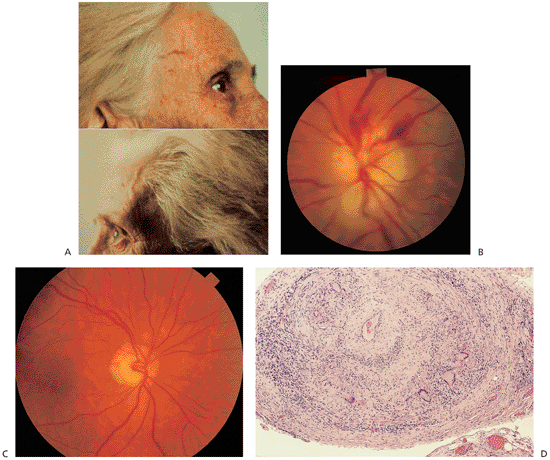 |
| A: Patient with visual loss demonstrating large, indurated and nonpulsatile superficial temporal arteries (horizontal on her right temple and vertical on her left. B: Pale swollen optic disc with a characteristic chalk-white appearance. Nerve fiber layer hemorrhages are visible superiorly. The infarction extends into the retina inferiorly. C: Optic disc after resolution of an arteritic anterior ischemic optic neuropathy. The disc is pale but is also cupped, another typical feature of giant cell arteritis. D: Temporal artery biopsy specimen in which the lumen is almost obliterated. The vessel wall is thickened by an intense infiltrate of chronic inflammatory cells that includes multinucleated giant cells. An elastin stain (not shown) revealed segmental loss of the internal elastic lamina. |
P.318
Lesions of the Visual Pathway
The visual pathway begins with the neurosensory layer of the retina (i.e., rods and cones) and extends to the visual receptive area of the occipital cortex. A thorough knowledge of the neuroanatomy of the visual pathway is needed to understand the localizing value of the visual field test. For many years, the central visual field was measured on a tangent screen with various sizes of targets, and the full peripheral visual field was measured by the Goldmann perimeter. Modern visual field analysis usually is done by an automated method that measures a variable amount of the central field, depending on the program selected.
Normal Visual Field
The size of the normal monocular visual field depends on the size and color of the test target. However, it is considered to be 60 degrees nasally, 100 degrees temporally, 60 degrees superiorly, and 70 degrees inferiorly. The binocular field is an ovoid that is 200 degrees laterally and 130 degrees vertically. The normal blind spot, which represents the area of the optic disc, is remarkably constant in its dimensions. Because the disc lies in the nasal retina, the blind spot is projected into the temporal field. Measured at 1 m, its center is 15.5 degrees temporal to fixation and 1.5 degrees below the horizontal meridian. It is 5.5 degrees wide and 7.5 degrees high, and because there are no receptive cells in the disc the blind spot is an absolute scotoma. With both eyes open, the blind spot cannot be detected because of the overlapping binocular field.
The diagnosis of lesions involving the visual pathways is made by associated neuro-ophthalmic signs. Primary among these is the pattern of visual field loss. The pattern can be exquisitely localized, pointing to specific anatomic areas of the visual pathway (Fig. 9.1). Although the era of sophisticated magnetic resonance imaging (MRI) and computed tomography (CT) studies has reduced the importance of determining the visual field, it remains a valuable, inexpensive diagnostic procedure.
Types of Visual Field Defects and Terminology
The pattern of a visual field defect depends on the composition and configuration of the visual pathway fibers in the affected area. It is helpful to divide the visual pathway into prechiasmal (i.e., retina and optic nerve), chiasmal, and postchiasmal sections.
There are essentially five patterns of field defects resulting from visual pathway lesions: central or centrocecal scotoma; arcuate or altitudinal scotoma; temporal wedge scotoma; generalized depression; and hemianopia. Only one of these defects, the hemianopia, occurs with lesions between the optic chiasm to the occipital lobe. The other four defects are produced by lesions that may be at any location between the retina and the prechiasmal optic nerve.
Certain terms are used to describe visual field defects. A
P.319
P.320
scotoma is an area of decreased vision in the seeing field. A visual field defect may be relative or absolute. A relative defect varies in size or density according to the size, color, and intensity of the test stimulus, and an absolute defect is the same for all test targets. The term homonymous means the same side of the visual field is affected in each eye, and hemianopia refers to one half of the field in which the defect obeys the vertical meridian. If the defect involves one fourth of the field and obeys the vertical meridian, the term quadrantanopia is used. A homonymous defect may be congruous (i.e., the same in each eye) or incongruous (i.e., shaped differently between the two eyes).
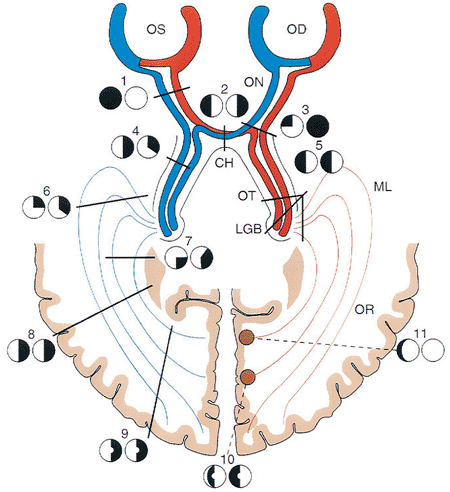 |
Figure 9.1. Schematic illustration of the visual pathway and visual field defects produced by lesions in various areas of the pathway. ON, optic nerve; CH, chiasm; OT, optic tract; LGB, lateral geniculate body; ML, Meyer's loop; OR, optic radiations. 1. Compromise of the left optic nerve results in a central scotoma in the left eye, with a normal right visual field. 2. A lesion of the optic chiasm may cause a bitemporal hemianopia. 3. A lesion at the junction of the right optic nerve and the chiasm results in a central scotoma in the right eye and a superior visual field defect that respects the vertical meridian in the left eye. This effect results from compromise of the inferior nasal crossing fibers from the left eye, which extend into the prechiasmal portion of the right optic nerve (i.e., Wilbrand's knee). The resulting visual field defect is known as a junctional scotoma, which is localized at the junction of the optic nerve and chiasm. 4. Complete interruption of the optic tract produces a homonymous hemianopic field defect. Subtotal lesions produce highly incongruous homonymous hemianopias. 5. Complete interruption of the optic tract, lateral geniculate body, and optic radiations results in a total contralateral homonymous hemianopia. 6. Fibers originating in the ipsilateral inferior temporal retina and the contralateral inferior nasal retina sweep anteriorly and laterally around the temporal horn (i.e., Meyer's loop) before transversing posteriorly. As a result, lesions of the temporal lobe characteristically produce superior, often incongruous homonymous quadrantanopias. 7. Parietal lobe lesions may interrupt visual pathway fibers from the superior retinas pursuing a more direct posterior course. This results in an inferior homonymous quadrantanopia. 8. Complete interruption of the optic radiations results in contralateral total homonymous hemianopia. 9. Posterior occipital lobe lesions result in homonymous hemianopic defects, which may spare the macula. Subtotal occipital lesions produce exquisitely congruous visual field defects because the fibers are more highly segregated in the occipital area. 10. Lesions affecting the posterior portion of the occipital lobe may spare the more anteriorly placed unpaired crossing peripheral nasal retinal fibers, resulting in a preserved temporal crescent in an otherwise congruous homonymous hemianopia. 11. Focal lesions involving the anterior-most portion of the occipital lobe may affect the receptive area for the unpaired crossing fibers from the contralateral nasal retina, resulting in a unilateral peripheral temporal visual field defect. (Modified from Harrington DO, Drake MV. The visual fields: Text and atlas of clinical perimetry. 6th ed. St. Louis: CV Mosby; 1990, with permission.) |
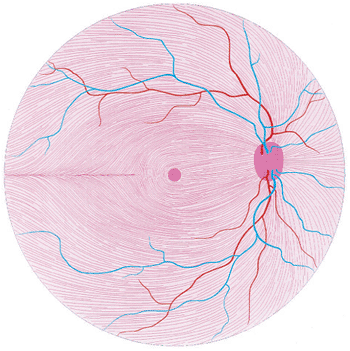 |
Figure 9.2. Schematic representation of the course of ganglion cell axons in the retina. The retinotopic origin of these nerve fibers is respected throughout the visual pathway. (Modified from Harrington DO, Drake MV. The visual fields. 6th ed. St. Louis: CV Mosby; 1990, with permission.) |
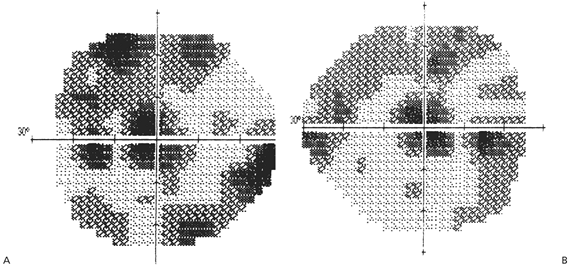 |
Figure 9.3. Bilateral central scotomas in a patient with nutritional optic neuropathy and with considerable depression throughout the tested field. |
Prechiasmal Visual Field Defects
Axons of ganglion cells inferior to the horizontal raphe project into the inferior portion of the optic disc (Fig. 9.2). Those originating nasal to the fovea cross in the chiasm, and those from the temporal retina remain ipsilateral. Axons from ganglion cells superior to the horizontal course superiorly through the retina and tend to remain superior throughout the visual pathway. Axons in the papulomacular bundle pursue a more direct course into the temporal aspect of the disc but respect their retinotopic vertical and horizontal origin in the visual pathway.
A lesion of the retina or optic nerve can produce four types of monocular visual field loss: central or centrocecal scotoma; arcuate or altitudinal scotoma; nasal radial scotoma; and generalized depressions.
Central and Centrocecal Scotomas
A process that affects the macula or optic nerve may result in a central scotoma (Fig. 9.3). This scotoma may cross the vertical and horizontal midlines but does not extend to the blind spot.
A more extensive lesion of the papulomacular bundle or optic nerve produces a scotoma involving fixation and the
P.321
physiologic blind spot and is designated a centrocecal scotoma (Fig. 9.4).
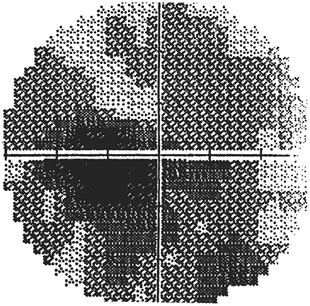 |
Figure 9.4. Centrocecal scotoma in the left eye of a 28-year-old woman with a sudden decrease in vision. |
Arcuate or Altitudinal Scotomas
Involvement of nerve fiber bundles produces an arcuate scotoma that extends from the blind spot to the horizontal meridian, which is the perimetric representation of the horizontal raphe (Fig. 9.5A). An altitudinal defect may involve the superior or inferior portion of the visual field (Fig. 9.5B).
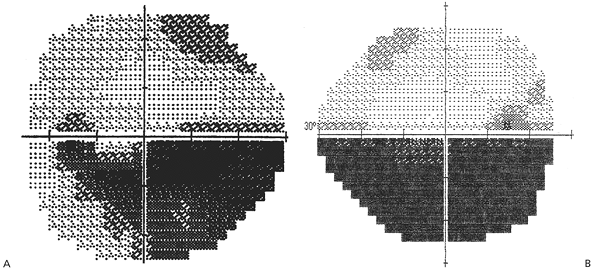 |
Figure 9.5. A: An inferior arcuate scotoma in the visual field of the left eye extends from the blind spot to the horizontal midline nasally. Glaucoma is the most common cause of arcuate scotomas, although any lesion of the optic nerve or retina can produce similar visual field defects. B: Inferior attitudinal scotoma in the right eye of a patient with nonarteritic anterior ischemic optic neuropathy. |
Temporal Wedge Scotoma
Because the nasal retinal nerve fibers reach the optic disc directly, any lesion involving these fibers produces a wedge scotoma.
Generalized Depression
Generalized depression is a nonlocalizing defect that may be produced by a variety of causes, including cataract, diffuse retinal disease, and optic nerve compression (Fig. 9.6).
Optic Chiasm Defects
The Optic Chiasm
The optic chiasm is a structure created by the joining of the optic nerves. The nerve fiber arrangement of the optic disc is essentially that of the retina, but as the fibers travel toward the optic chiasm, they rotate within the optic nerve and eventually line up along the vertical meridian. Because the optic nerve is essentially a cone projection system with most of the fibers subserving the papulomacular bundle, any lesion anterior to the chiasm that involves the optic nerve is likely to produce a central scotoma, although arcuate or altitudinal defects do occur.
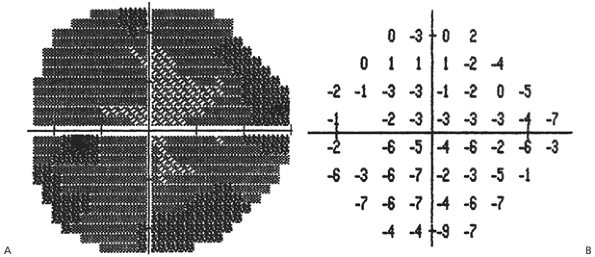 |
Figure 9.6. Generalized depression of the left visual field results from a moderately dense cataract and no other obvious ocular pathology. A: Gray scale. B: Pattern deviation fails to reveal any recognizable pattern of field loss. |
P.322
As the optic nerves converge to form the optic chiasm, two important events occur: the fibers rotate to respect the vertical perimetric meridian, and the nasal retinal fibers of each eye cross to the opposite side. The fibers from the inferior nasal retina cross in the inferior portion of the optic chiasm, and those from the superior nasal retina remain superiorly. The inferior nasal fibers also extend forward into the contralateral optic nerve after crossing in the optic chiasm (i.e., Wilbrand's knee; Fig. 9.7). However, recently it has been suggested that Wilbrand's knee is an artifact of monocular enucleation as it has not been identified in the normal primate monkey, but shown to form gradually over a period of years following monocular enucleation.
The optic chiasm sits above the sella turcica, which houses the pituitary; the optic chiasm rests 10 mm above this gland. The result of this anatomic configuration is that only very large pituitary tumors are able to produce visual loss. Microadenomas do not cause chiasmal visual field abnormalities.
Clinical Features
More than 90% of chiasmal syndromes are produced by mass lesions, most commonly pituitary tumors, craniopharyngiomas, meningiomas, and gliomas. These tumors also may produce a variety of endocrine abnormalities. Involvement of the optic chiasm usually produces visual acuity loss and bilateral visual field defects. The hallmark of chiasmal compression is bitemporal hemianopia (Fig. 9.8). Another pattern, the junctional scotoma, is the most frequently encountered form of chiasmal visual field loss. A junctional scotoma occurs when a mass lesion may involve the optic chiasm and one of the optic nerves. This pattern of involvement produces a central scotoma in one eye with decreased central acuity and a superior temporal depression that respects the vertical midline in the other eye. Traditionally this was said to be because of involvement of Wilbrand's knee (Figs. 9.1, 9.7). An alternative explanation is that it occurs because of combined compression of the optic chiasm and one (or both) optic nerves.
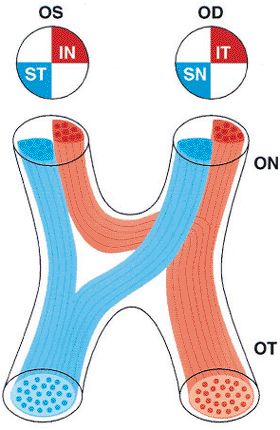 |
Figure 9.7. Schematic illustration of crossing fibers in the optic chiasm. The inferior nasal fibers from the left eye extend into the prechiasmal right optic nerve, forming Wilbrand's knee. ON, optic nerve; OT, optic tract; IN, inferior nasal; ST, superior temporal; IT, inferior temporal; SN, superior nasal. (Modified from Glaser JS. Anatomy of the visual sensory system. In: Tasman W, Jaeger EA, eds. Clinical ophthalmology, vol 2. 1994:4.) |
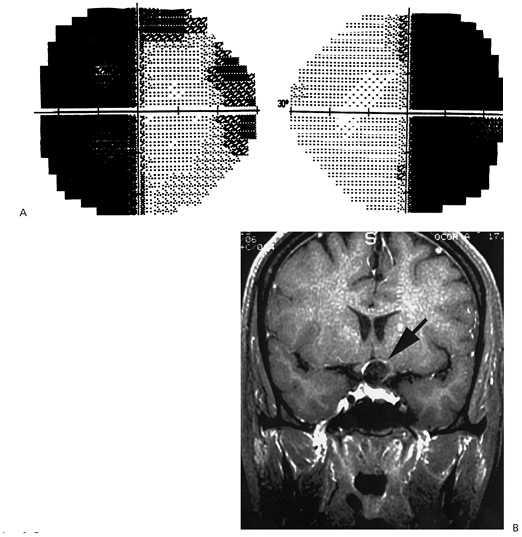 |
Figure 9.8. A: Bitemporal hemianopia in a 34-year-old woman. B: Coronal magnetic resonance imaging reveals a cystic lesion in the chiasmal region, which proved at surgery to be a craniopharyngioma. |
P.323
These two defects the bitemporal hemianopia and the junctional scotoma exquisitely localize the lesion to the perichiasmal area.
Rarer types of scotomas may be encountered with chiasmal compression, depending on the anatomic variability of the chiasm in relation to the sella turcica. If the chiasm is postfixed, the intracranial optic nerves are longer, and upward expansion of a pituitary tumor impinges mainly on the perichiasmal optic nerves, producing bilateral central scotomas instead of a hemianopic defect. If the chiasm is prefixed, the posterior portion of the chiasm and a portion of the optic tracts rest over the sella turcica, and compression produces an incongruous homonymous hemianopia (i.e., optic tract syndrome).
Double vision may also be a sign of perichiasmal mass lesions. A type of double vision peculiar to chiasmal compression is the hemifield slide phenomenon. Affected patients complain of vertical displacement of columns of figures or lines on a printed page, because the bitemporal hemianopia destroys the interlocking mechanism for reading. Double vision may be produced by ocular misalignment, because pituitary tumors and other large perichiasmal mass lesions may also compromise the third, fourth, or sixth nerves in either cavernous sinus.
Management
Any patient presenting with a possible perichiasmal lesion must have a gadolinium-enhanced MRI scan. This is the best imaging technique for this area, and because 90% of chiasmal syndromes are produced by mass lesions, it is the first test to be ordered. Lesions other than tumors may produce chiasmal syndromes. If no mass is
P.324
found, investigation for other causes, such as demyelinating disease, sarcoidosis, or trauma, should be undertaken.
Postchiasmal Visual Field Defects
The components of the postchiasmal visual pathway are the optic tract, lateral geniculate body, and the optic radiations (Fig. 9.1). The fibers originating in the ipsilateral temporal retina are joined by fibers from the contralateral nasal retina to form the postchiasmal pathway. Therefore, lesions of this portion of the visual pathway produce hemianopias in the visual fields of both eyes that are homonymous.
Complete interruption of the postchiasmal visual pathways at any point from the optic tract to the occipital lobe results in a complete contralateral homonymous hemianopia. Complete hemianopias cannot be localized to a specific part of the visual pathway on the basis of the visual field alone. A visual field defect must be less than complete in order to be localizing to a specific area of the postchiasmal pathway.
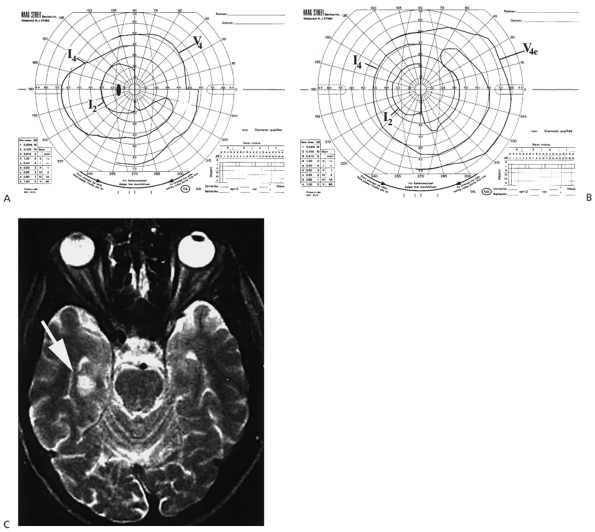 |
Figure 9.9. Highly incongruous right homonymous hemianopia resulting from a nonmass lesion at the junction of the chiasm and left optic tract. A: Left eye. B: Right eye. C: Contrast-enhanced axial magnetic resonance scan, showing an infarct in the area of the left optic tract (arrow). |
Optic Tract
The optic tract is the continuation of the visual fibers between the optic chiasm and the temporal lobe. An optic tract lesion is uncommon. Its characteristics depend on the cause. Two types of optic tract syndromes have been described.
Compressive optic tract syndrome most frequently is caused by a craniopharyngioma but may also result from pituitary tumors.
P.325
The syndrome consists of a highly incongruous homonymous hemianopia contralateral to the side of the lesion, decreased acuity, and a relative afferent pupillary defect (RAPD) both ipsilateral to the side of the lesion and produced by compression of the optic chiasm and occasionally of the optic nerve.
An optic tract lesion produced by a demyelinating plaque, vascular occlusive phenomenon, or other nonmass lesion produces an incongruous homonymous hemianopia without decreased central acuity (Fig. 9.9). Patients do have an RAPD ipsilateral to the homonymous hemianopia (i.e., contralateral to the lesion), because the RAPD is on the side of the temporal visual field loss, which is greater than the nasal visual field loss in the contralateral eye.
Management
Any patient with a homonymous hemianopia requires MRI with gadolinium.
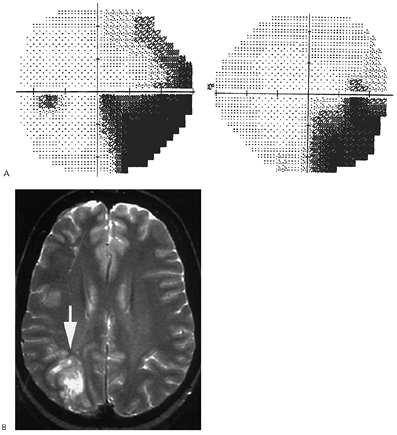 |
Figure 9.10. A: The right inferior homonymous quadrantanopia resulted from a lesion of the left parietal lobe. B: Magnetic resonance imaging demonstrates enhancement of an infarcted area in the left parietal lobe. |
Optic Radiations
The optic radiation portion of the visual pathway extends from the lateral geniculate body to the occipital lobe. As the fibers leave the lateral geniculate body, they course anteriorly around the temporal horn to form Meyer's loop (Fig. 9.1). Involvement of this area produces a superior homonymous quadrantanopia (Fig. 9.1). Other nonocular signs of temporal lobe dysfunction include temporal lobe epilepsy and formed visual hallucinations.
As the visual fibers course toward the occipital lobe, they become more segregated, and the more posterior the lesion, the more congruous is the homonymous hemianopia. Parietal lobe lesions routinely produce inferior quadrantic visual field loss, which tends to be more congruous than that produced by temporal lobe lesions (Figs. 9.1, 9.10).
P.326
Occipital lobe lesions are often seen first by ophthalmologists, because patients may present only with visual problems and no other neurologic signs or symptoms. The hallmark of occipital lobe disease is the exquisitely congruous homonymous hemianopia (Fig 9.11). Two perimetric peculiarities are observed in some occipital lobe lesions. The first feature is preservation of the temporal crescent. An area in the anterior interhemispheric fissure contains an unpaired projection from the nasal retina. Lesions of the occipital lobe may spare this area, and the patient presents with an otherwise congruous hemianopia, but the crescent around the temporal portion of the visual field remains intact (Fig. 9.12). The temporal crescent is in the extreme temporal visual field. It is widest in the horizontal meridian where it extends from 60 degrees to approximately 90 degrees. Therefore, it cannot be identified on the 24-2 and 30-2 visual field tests. The second feature is macular sparing. Some homonymous hemianopias of occipital lobe origin appear not to involve a small area around fixation in the hemianopic field (Fig. 9.1). Although the exact mechanism for this finding is still controversial, it is not an artifact. It can be exquisitely localized to the occipital lobe.
Management
The most frequent occipital lobe lesion is ischemia, particularly in older patients. However, MRI with gadolinium is indicated for all patients with any newly discovered homonymous hemianopias.
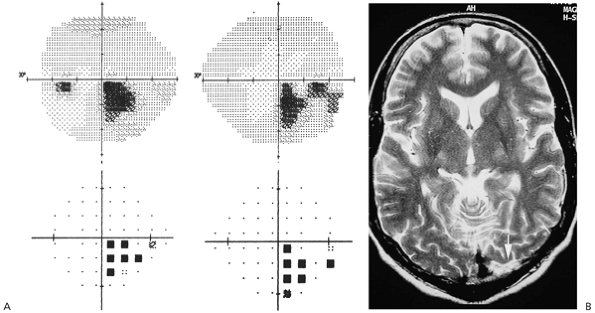 |
Figure 9.11. A: Right congruous inferior homonymous quadrantanopia. B: Magnetic resonance imaging demonstrates enhancement of an infarcted area of the left occipital lobe (arrow). |
Optic Nerve Abnormalities
Optic Neuritis
The term optic neuritis signifies inflammation or demyelination of the optic nerves. It is a clinical syndrome that strictly may be applied to any inflammation (e.g., sarcoidosis, Lyme disease), but convention usually implies demyelination.
Clinical Features
Patients affected are almost invariably younger than 45 years of age. The visual changes are characterized by a sudden decrease in visual acuity, usually in one eye, preceded or accompanied by pain on movement of the eye. Pain on movement of the eye is an extremely important sign that occurs in more than 90% of patients with optic neuritis.
The visual acuity may be normal in optic neuritis, or it may be decreased to the level of no light perception. Visual field abnormalities in the form of a centrocecal scotoma or an altitudinal defect are common, as are acquired dyschromatopsia and an RAPD. The optic disc may be normal in the retrobulbar variety of optic neuritis or may be swollen with a few cells overlying the swollen disc in cases of papillitis (Fig. 9.13). Long-term disc appearance may be normal or may show optic nerve atrophy (Fig. 9.14).
Management
The Optic Neuritis Treatment Trial (ONTT) divided patients with acute optic neuritis into
P.327
three treatment groups: intravenous methylprednisolone followed by oral taper; placebo; and oral prednisone alone. Isolated optic neuritis in its typical form requires no laboratory investigations. Cerebrospinal fluid (CSF) examination is also not mandatory in typical cases of optic neuritis.
 |
Figure 9.12. Temporal crescent. The patient has an incomplete right homonymous hemianopia, which appears incongruous but is very congruous except for a preserved temporal crescent to the I-4-E and V-4-E isopter in the right eye (i.e., Goldmann perimeter). |
Because of the high association of subsequent development of multiple sclerosis (MS) in patients with isolated optic neuritis who have abnormal MRI scans, an MRI scan may be done at the onset of the visual disturbance (Fig. 9.15). The 5-year follow-up results of the ONTT showed that the cumulative probability of developing clinically definite MS was 30% and did not differ by treatment group. However, the number of lesions on the brain MRI at study entry was a stronger predictor for the development of MS. If there were no MRI lesions, the 5-year risk of MS was 16%, but increased to 51% when three or more MRI lesions were present. Patients with no pain during the presentation of optic neuritis, mild visual acuity loss or optic disc swelling were identified as having a particularly low risk for the development of MS.
The ONTT has indicated that the ultimate recovery of vision is not affected by intravenous corticosteroid treatment. But treatment does hasten visual recovery. The only potential visual benefit would be in a one-eyed patient or a patient who desires rapid improvement in visual function. Oral corticosteroids alone should not be used because their use results in increased recurrences of optic neuritis in the same and fellow eye.
The Longitudinal Optic Nerve Study has shown that patients treated for acute optic neuritis with intravenous corticosteroids and who do have abnormal MRI scans have a much reduced risk of developing the signs and symptoms of MS over the 2 years following treatment. After this 2-year period, their risk approaches those of untreated patients (Table 9.1). It has been recommended that patients with acute optic neuritis should be treated with high does of intravenous corticosteroids, although not for visual reasons but to provide short-term protection against the development of MS.
Anterior Ischemic Optic Neuropathy
Anterior ischemic optic neuropathy (AION) is the result of an infarction of the optic nerve head caused by compromise of the posterior ciliary artery circulation. Two general varieties of AION are recognized: a nonarteritic or idiopathic form and an arteritic form, secondary to giant cell arteritis.
Clinical Features
AION occurs in the vasculopathic age group and may result in decreased acuity, visual field defects, and a swollen, variably pale optic disc (Fig. 9.16).
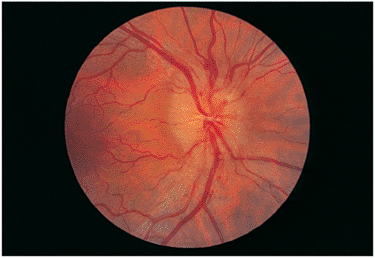 |
Figure 9.13. Papillitis. A 22-year-old woman noticed a sudden decrease in vision in her right eye and pain on eye movement. The disc is elevated and the margins blurred, with opacification of the nerve fiber layer inferiorly. The contralateral disc is normal. |
 |
Figure 9.14. Optic nerve atrophy. A 30-year-old man developed retrobulbar neuritis in the right eye. His initial vision was 20/200. Four months later, temporal pallor of the right disc was seen (left), but vision had improved to 20/25. The left disc was normal. |
P.328
Nonarteritic AION occurs typically in patients older than 45 years of age, is sudden in onset, and is painless. The visual decrement can be mild to severe. Usually, the superior or inferior portion of the nerve is edematous and pale, and classically, there is a resultant altitudinal visual field defect (Fig. 9.17). Visual acuity is usually better preserved than in the arteritic variety, and the visual field defects tend to be stable. The fellow eye usually shows an optic disc with no cup, suggesting crowding of the retinal nerve fiber layer, which may contribute to the infarction process. The incidence of subsequent infarction in the second eye ranges from 14% to 35%. The risk of recurrent event to the same eye is 4%.
 |
Figure 9.15. Magnetic resonance imaging shows typical white matter lesions that are indistinguishable from those seen in multiple sclerosis. |
Arteritic AION results from giant cell (temporal) arteritis. The optic disc is usually paler than in the nonarteritic variety, and some areas of retinal ischemia may be seen (Fig. 9.18). The visual acuity is usually worse than in the nonarteritic variety, and the patients usually are older than 65 years of age. The symptoms associated with giant cell arteritis include those of polymyalgia rheumatica (e.g., stiffness and pain of the neck and shoulder muscles, weight loss, fever). Other common symptoms include pain in the jaw muscles on chewing, chronic headache, and tenderness in the forehead and temporal scalp areas. Sometimes an enlarged, nonpulsating temporal artery is palpable. A Westergren erythrocyte sedimentation rate (ESR) is usually elevated. Cupping of the optic disc is the most common end-stage disc appearance of arteritic AION, but occurs infrequently in nonarteritic AION (Fig 9.19).
Management
A Westergren ESR should be drawn immediately, and temporal artery biopsy should be performed if giant cell arteritis is suspected. The temporal artery does
P.329
not need to show giant cells to establish the diagnosis, but it must show signs of inflammation (Fig. 9.20).
Table 9.1. Cumulative Percentage of Patients with Clinically Definite Multiple Sclerosis by Treatment Group | |||||||||||||||||||||||||||||||
|---|---|---|---|---|---|---|---|---|---|---|---|---|---|---|---|---|---|---|---|---|---|---|---|---|---|---|---|---|---|---|---|
| |||||||||||||||||||||||||||||||
 |
Figure 9.16. Nonarteritic anterior ischemic optic neuropathy. A: Acute onset of superior segmental swelling of the right optic disc, with 20/20 vision. B: Two weeks later, vision diminished to hand movements, the inferior disc was swollen, and the superior portion was becoming pale and atrophic. This type of second infarction in the same eye is rare, occurring in 4% of patients. |
Systemic corticosteroids should be administered immediately in the arteritic form to prevent further visual loss, especially in the other eye. At least 80 to 100 mg of prednisone is required daily, and some physicians recommend high-dose intravenous steroids initially. The presence of AION and an elevated ESR are sufficient to institute steroid treatment. A temporal artery biopsy should be done as soon as possible, but treatment should not be delayed pending biopsy results, because the other eye is at risk. Steroid treatment must continue for months.
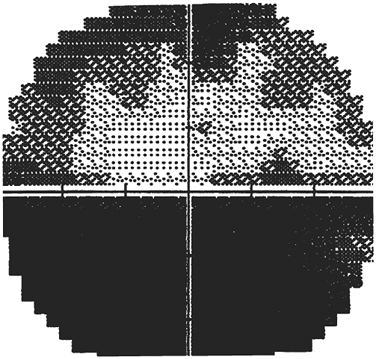 |
Figure 9.17. Inferior attitudinal defect in the right eye of the patient in Figure 9.16, as seen at initial presentation. |
No treatment is useful for acute nonarteritic AION. A minority of patients may show progression of AION, with further loss of visual acuity or visual field.
Papilledema
Papilledema is bilateral optic disc elevation due to increased intracranial pressure. There is little or no true edema, because the disc elevation is caused by damming of the axoplasmic flow at the lamina cribrosa in response to increased perineural pressure. The exact mechanism by which increased intracranial pressure results in papilledema is unknown.
Clinical Features
Papilledema is divided into sequential stages. Early or incipient papilledema is characterized by minimal disc hyperemia, early nerve fiber layer opacification, and a loss of spontaneous venous pulsations (Fig. 9.21).
P.330
Acute or developed papilledema is expressed as peripapillary nerve fiber layer hemorrhages and, sometimes, as exudates (Figs. 9.22, 9.23). Disc elevation is more prominent than in the early form. In chronic papilledema, the hemorrhages and exudates disappear, and the disc develops a yellowish appearance (Fig. 9.24). Crystalline deposits that resemble disc drusen but are accumulations of axoplasmic debris may be present. Collateral circulatory channels in the form of optochoroidal shunt vessels may be seen. In atrophic papilledema, the optic disc is pale and flatter than in other stages. The nerve fiber layer is thinned, and concentric peripapillary pigment alterations indicate the boundaries of the previous disc edema (Fig. 9.25).
 |
Figure 9.18. Arteritic anterior ischemic optic neuropathy. The optic disc is extremely pale, a sign of giant cell arteritis, and an adjacent area of the retina is infarcted. |
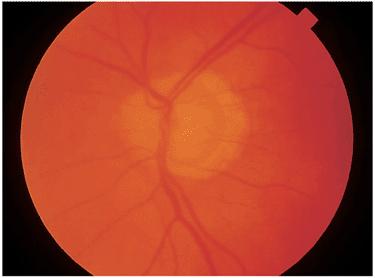 |
Figure 9.19. Cupping of the optic nerve in end-stage arteritic anterior ischemic optic neuropathy secondary to giant cell arteritis. |
Patients with papilledema from any cause may experience several symptoms. Transient visual loss lasts for seconds in one or both eyes and frequently occurs when going from a supine to standing position. Diplopia related to a unilateral or bilateral cranial nerve VI palsy is a nonlocalizing sign of increased intracranial pressure. Visual field defects begin as enlarged blind spots, but with attrition of the nerve fiber layer arcuate defects similar to the progression of field loss in glaucoma may develop. A marked loss of peripheral vision is a late finding. Visual acuity loss occurs only late in the course of papilledema, after severe visual field loss has occurred. However, vision may decrease earlier if the patient has macular exudates, edema, or other retinal surface changes.
 |
Figure 9.20. A: Temporal artery biopsy in giant cell arteritis reveals a chronically inflamed artery with marked narrowing of the lumen. (Hematoxylin and eosin stain; original magnification 10). B: Higher magnification shows chronic inflammatory cells, including lymphocytes, epithelioid histiocytes, and giant cells in the wall of the thickened vessel. Segmental destruction of the muscularis and internal elastic lamina has occurred. The lumen is narrowed, and subintimal fibrosis is present (hematoxylin and eosin stain; original magnification 25; photograph courtesy of Ralph C. Eagle Jr, M.D., Philadelphia, PA.) |
Management
Bilateral optic disc elevation, especially in the absence of signs of optic nerve dysfunction, must raise the possibility of papilledema due to increased intracranial pressure. Immediate imaging, preferably MRI, is performed to detect an intracranial mass lesion or hydrocephalus. If the result is normal, a lumbar puncture (LP) is performed to establish the diagnosis of increased intracranial pressure and to analyze the contents of the spinal fluid. Causes of papilledema other than intracranial mass lesions include pseudotumor cerebri and inflammatory, infectious, and malignant meningitis.
Idiopathic Intracranial Hypertension
Idiopathic intracranial hypertension (IIH) is a disorder with a strict group of clinical signs. Papilledema is usually present, but rarely the discs may appear normal. Neurologic imaging does not reveal a mass lesion or hydrocephalus. The CSF composition is normal, but opening pressure is increased. Other neurologic signs are absent, except for sixth nerve palsy. No underlying cause is found in IIH. When an underlying cause is identified, the disorder is called pseudotumor cerebri due to (whatever the cause may be).
Clinical Features
Patients who have this condition may suffer from headaches, transient visual obscuration in one or
P.331
P.332
both eyes that lasts for seconds, or double vision attributable to unilateral or bilateral sixth nerve palsies (Fig. 9.26).
 |
Figure 9.21. Early papilledema with disc elevation, blurring of the margins, hyperemia, and venous engorgement in the (A) right eye and (B) left eye. |
 |
Figure 9.22. Acute papilledema with increased elevation and hemorrhages on the disc surface in the (A) right eye and (B) left eye. |
 |
Figure 9.23. Acute papilledema with more extensive disc elevation and cotton-wool infarcts in the (A) right eye and (B) left eye. The left eye also has retinal folds developing between the disc and macula. |
 |
Figure 9.24. Chronic papilledema. A: Right eye, showing elevation and residual hemorrhages. B: The left disc is yellowish, and the hemorrhages have disappeared. Small shunt channels are developing on each disc. |
IIH is found mostly in young obese women, although it may occur in children and in men. Pseudotumor cerebri can be produced by the administration or withdrawal of corticosteroids, excessive doses of vitamin A, tetracycline (including the semisynthetic varieties), NegGram, Cytoxan, and dural sinus thrombosis. In the absence of one of these or other causes, when the strict criteria for pseudotumor cerebri have been fulfilled, the disorder is said to be idiopathic.
The major permanent deficit these patients can suffer is visual loss. This occurs because of chronic papilledema, and the progression of the visual field loss is identical to that of glaucoma, commencing with only an enlarged blind spot and then progressing to arcuate defects, peripheral constriction of the field, and finally, marked constriction, leaving only a small central tunnel of vision. Acuity is lost late in the evolution of the chronic papilledema. In any patient with papilledema, even a morbidly obese young woman, imaging and LP are required to establish the diagnosis of IIH or pseudotumor cerebri.
Management
All patients suspected of having IIH need to have neuroimaging that excludes the presence of other intracranial pathology and an LP that should reveal normal CSF composition with an elevated opening pressure. If the CSF pressure is normal, but the clinical picture is suggestive of IIH, a repeat LP should be performed. A CT venogram or MRI venogram should be done to exclude dural sinus thrombosis.
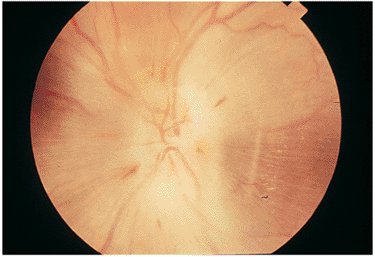 |
Figure 9.25. Atrophic papilledema. The optic disc is pale and flat. Concentric pigment alterations indicate the extent of the peripapillary edema. |
Not all patients who have pseudotumor cerebri require treatment. If the patient is asymptomatic, the papilledema is relatively acute, but the patient has no visual field deficit, observation is permissible.
If weight loss does not result in resolution of the syndrome, progressive visual field loss occurs, or the optic discs are tending toward chronic papilledema, treatment with acetazolamide may be instituted. Acetazolamide, however, should be used in dosages of 2 to 5 g daily, depending on the patient's weight. If this medication does not relieve the syndrome, an operative procedure is indicated. Optic nerve sheath decompression is an excellent operation if the visual symptoms are paramount. Lumboperitoneal shunting may be more useful if headache is incapacitating.
The ophthalmologist's duty when following a patient with pseudotumor cerebri is to perform sequential visual field and fundus examinations to be sure that progressive visual field deterioration is not evolving.
Diabetic Papillopathy
Optic disc edema occurs in patients with type I or II diabetes mellitus.
Clinical Features
This is considered to be an atypical form of nonarteritic AION. Visual symptoms are usually minimal and resolve within several weeks, but may be severe and permanent. Although initially described in young insulin-dependent diabetics, it has been documented to occur as frequently in adult-onset diabetes mellitus. The disc swelling may be unilateral or bilateral. Eyes with diabetic papillopathy show a swollen, hyperemic disc with prominent, dilated, telangiectatic vessels over the disc that may mimic optic disc neovascularization (Fig. 9.27). Disc edema resolves
P.333
P.334
within 3 to 4 months, often without optic atrophy. The visual loss is mild and usually improves. Macular edema and background diabetic retinopathy frequently are present. Like patients with typical nonarteritic AION, patients with diabetic papillopathy seem to have a higher prevalence of disc at risk or small cup-to-disc ratios (<0.1).
 |
Figure 9.26. Pseudotumor cerebri. Papilledema in a 24-year-old, obese woman with severe headaches and obscuration of vision. The opening spinal fluid pressure was 600 mm H2O. A: Right eye. B: Left eye. |
 |
Figure 9.27. Diabetic papillopathy. A: Acute swelling of the right disc in a 74-year old, insulin-dependent diabetic of 25 years' duration. Hemorrhages, blurred disc margins, and optic disc edema are evident with (B) corresponding superior nerve fiber layer visual field defect seen on automated Humphrey perimetry. C: Same optic disc 3 months later shows significant resolution of the optic disc swelling with (D) improvement of the visual field. |
 |
Figure 9.28. Hypertensive retinopathy in a 56-year-old woman with advanced renal disease and a blood pressure of 225/160 mm Hg. A: Right eye with edema of the disc, striated hemorrhages, edema residues in the form of a macular star, and vision limited to hand movements at 6 feet. B: The left eye has a macular star but minimal edema of the disc. Vision was 20/25. One year later, vision in the right eye improved to 20/40. |
Management
No specific treatment of the papillopathy is indicated.
Optic Neuropathy in Hypertension
Edema of the optic disc may be seen in patients with uncontrolled hypertension. Decreased visual acuity and visual field changes vary. The condition may be unilateral or bilateral. Cotton-wool spots, hard exudates, hemorrhage, and capillary drop-out may be associated with the disc swelling. Other signs of hypertensive retinopathy are often present (Fig. 9.28).
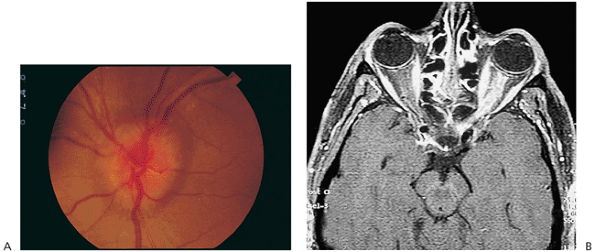 |
Figure 9.29. A: Unilateral disc edema in a 56-year-old woman with a meningioma involving the left optic nerve sheath. B: T1-weighted magnetic resonance imaging of orbit and brain demonstrating enhancement of the left optic nerve by an optic nerve meningioma. |
Originally, edema of the optic discs in cases of severe hypertension was thought to be a sign of increased intracranial pressure. It is now considered to be a form of AION. Other theories postulated include a breakdown of the blood-retinal barrier and ischemia of the optic nerve head with resultant axoplasmic stasis.
Compressive Optic Neuropathy
The hallmark of any compressive optic neuropathy is a slowly progressive evolution of the signs of optic nerve disease, which include decreased acuity, dyschromatopsia, RAPD, and an optic nerve type of visual field defect. Ophthalmoscopically, the optic disc may appear swollen, normal, or atrophic.
P.335
Optic Nerve Tumors
Clinical Features
Optic nerve tumors may result in a swollen disc initially but optic nerve pallor eventually develops (Fig. 9.29). Optochoroidal shunt vessels may develop on the disc surface (Fig. 9.30). These vessels represent an alternative pathway for blood to egress the eye when the normal venous return is impaired.
The syndrome of optic atrophy and optochoroidal shunt vessels is usually caused by a perioptic meningioma in adults (usually middle-aged women) and a glioma in children. Proptosis and resistance to retropulsion of the globe may be evident with either tumor.
Management
Management is controversial for optic nerve meningiomas and gliomas. No treatment is indicated if the lesion is localized to one optic nerve and does not appear to be extending intracranially and if visual acuity is preserved. Any surgery on the optic nerve produces immediate loss of vision.
A few authors still advocate orbital exenteration for meningiomas in children and surgical extirpation of gliomas. Radiation therapy has been advocated to retard the growth of both tumors.
Orbital Optic Nerve Compression
Many orbital processes may produce a compressive optic neuropathy.
Clinical Features
The more common orbital conditions resulting in optic nerve compression include orbital inflammatory disease (e.g., pseudotumor), Graves' disease, and infections. Proptosis is a common feature. When ocular motility disturbances accompany decreased vision and proptosis, the term orbital apex syndrome is appropriate. The appearance of the optic nerve and visual field defects varies. If the process interferes with venous return, the optic nerve may be swollen. If the compression is slow to develop, as can occur with a tumor, optic atrophy may be seen.
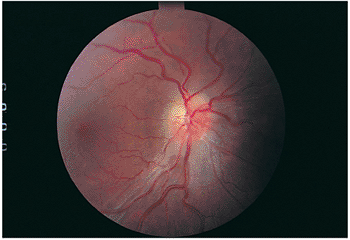 |
Figure 9.30. In a 12-year-old girl with an optic nerve glioma, the disc is becoming pale superiorly, with marked nerve fiber loss. An early shunt vessel is forming at 9 o'clock, off the central retinal vein. |
The optic neuropathy associated with Graves' disease is the result of compression of the optic nerve at the orbital apex by markedly enlarged extraocular muscles (Fig. 9.31). Patients who develop this syndrome usually do not have marked proptosis but instead have dramatically increased resistance to retropulsion of the eyes.
Management
Imaging of the optic nerve is indicated when intraorbital optic nerve compression is suspected in Graves' disease. The management options for compressive optic neuropathy associated with Graves' disease with progressively decreasing visual function include low-dose orbital irradiation, systemic corticosteroids, and orbital decompression.
Intermittent Compression
Clinical Features
This unusual syndrome is produced when an orbital mass lesion causes optic nerve compression and decreased ocular blood flow in certain directions of gaze (Fig. 9.32). Directional gaze-induced amaurosis fugax is a sign of intraorbital optic nerve compression.
Management
Orbital imaging is indicated, and therapy usually consists of surgical removal of the mass.
Intracranial Compression
Clinical Features
This optic neuropathy is usually caused by perichiasmal mass lesions such as pituitary tumors, craniopharyngiomas, meningiomas, or aneurysms. Signs or symptoms of compression of other surrounding structures also may be present, such as chiasmal junctional syndrome or ocular misalignment due to cavernous sinus involvement. With intracranial compression, the optic disc usually is normal but becomes progressively swollen or atrophic. The sudden appearance of a chiasmal syndrome caused by rapid expansion of a pituitary tumor because of hemorrhage into or swelling of the tumor is called pituitary apoplexy (Fig. 9.33).
Management
MRI is superior to CT in diagnosing most
P.336
instances of intracranial optic nerve or chiasmal compression.
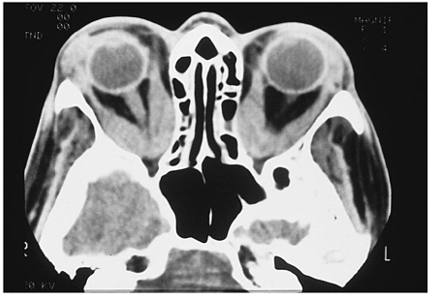 |
Figure 9.31. Graves' optic neuropathy. Axial computed tomography shows marked enlargement of the ocular muscles at the orbital apex. The medial walls of the orbit are bowed inward by the enlarged medial recti. |
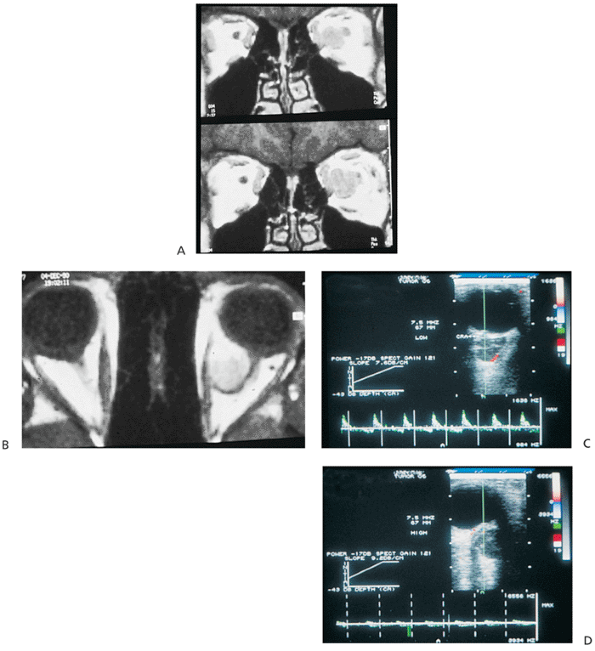 |
Figure 9.32. A: An orbital vascular mass lesion nasal to the right optic nerve is delineated by coronal magnetic resonance imaging. B: A mass lesion is visible in the medial portion of the right orbit. The left orbit is normal. On lateral gaze, the mass compressed the optic nerve, and vision fell to the level of no light perception, with an amaurotic pupil. C: Color Doppler orbital imaging shows a normal arterial flow and pulse wave in the central retinal artery in the primary position but (D) a complete lack of flow and flattening of the arterial pulse wave on lateral gaze. |
Toxic Optic Neuropathy
The optic nerve may be adversely affected by toxic substances, including specific medications prescribed for nonocular conditions.
Clinical Features
Decreased acuity, dyschromatopsia, and bilateral central or centrocecal visual field defects are the hallmarks of toxic optic neuropathy. Bilaterality and relative symmetric involvement are the rules. The visual loss may be mild to severe and may be sudden in onset or slowly progressive. The fundus examination is usually normal, although disc edema may be observed. Optic atrophy subsequently develops in most cases.
Methanol (i.e., wood alcohol) is a commonly available substance with significant ocular neurotoxic effects (Fig. 9.34). The severe systemic effects of methanol intoxication, including acidosis and cerebral dysfunction, usually accompany the visual loss. Disc edema may be present. Toluene, used by glue sniffers, is another substance that is toxic to the optic nerve.
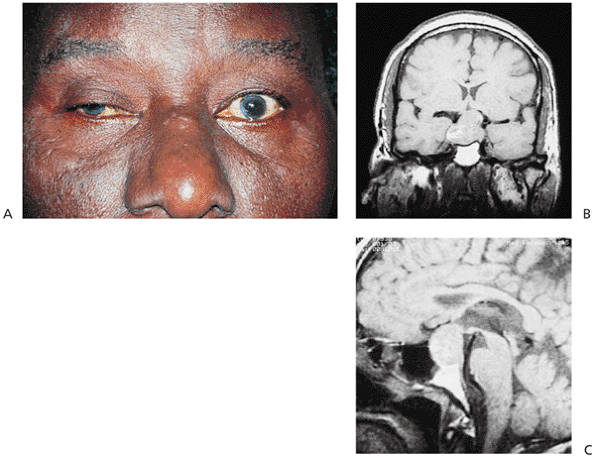 |
Figure 9.33. Pituitary apoplexy. A: Patient with a right cranial nerve III palsy. B: The coronal magnetic resonance scan shows a large pituitary tumor compressing the optic chiasm that caps the lesion. The tumor extends into the right cavernous sinus, causing the oculomotor problem. C: In this sagittal view [as well in coronal view (B)], blood appears as white areas in the tumor, indicating an acute hemorrhage. |
P.337
Drugs with reported optic nerve toxicity include chloramphenicol, the halogenated hydroxyquinoline, and the antituberculosis agents isoniazid and ethambutol. The clinician should maintain a high degree of suspicion for a toxic optic neuropathy when a patient presents with bilateral centrocecal scotomas and no other obvious cause.
 |
Figure 9.34. The right fundus of a commercial sailor who had been at sea for 3 weeks and drank methanol from the ship's compass. He was comatose and had dilated pupils. Examination 2 days after ingestion showed the discs to be swollen and pale. Retinal edema was also present. The patient died 2 days later. |
Management
The offending agent should be discontinued. There is no specific treatment for the optic neuropathy. Visual recovery is variable, but improvement occurs in many cases, with the exception of those associated with methanol ingestion. In methanol intoxication, reestablishment of the proper electrolyte balance and supportive measures are imperative.
Amiodarone Optic Neuropathy
Amiodarone has been documented to produce disc edema in a small percentage of patients. It has been documented to occur with treatment from 1 to 72 months, and the dosage varied from 200 to 1200 mg/day. Patients present with insidious unilateral or bilateral decreased vision that may gradually progress and is associated with optic nerve edema. The visual acuity and field loss tend to stabilize or improve following discontinuation of the medication. The major differences between nonarteritic AION and amiodarone optic neuropathy are that the visual loss is bilateral and insidious, and the optic disc swelling persists longer with amiodarone toxicity, tending to take months rather than weeks to resolve. The mechanism of amiodarone optic neuropathy is unknown, but histology has shown primary lipidosis of the optic nerve (Fig. 9.35).
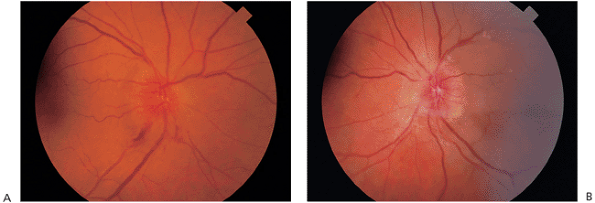 |
Figure 9.35. Amiodarone optic neuropathy. Bilateral disc edema with nerve fiber layer hemorrhages more prominent on the right disc. |
P.338
Optic Neuropathy Associated With Nutritional Deficiency
Optic neuropathy has been associated with a deficiency of B-complex vitamins, particularly thiamine. Originally, this type of neuropathy was thought to be associated with chronic tobacco or alcohol abuse. However, most authorities now think that the nutritional deficiency is the underlying cause.
 |
Figure 9.36. Nutritional-toxic optic neuropathy. A 36-year-old man noticed a gradual decrease in his vision over a 12-month period. He gave a history of serious alcohol abuse and poor dietary intake. Vision was 20/400 for the right eye and 20/200 for the left eye. Temporal pallor was seen in the (A) right disc and (B) left disc. C: Bilateral centrocecal scotomas were found on Goldmann visual field examination. |
Clinical Features
The findings are those of a toxic optic neuropathy, with decreased acuity, dyschromatopsia, and bilateral centrocecal scotomas (Fig. 9.36). Initially, the fundus is normal, although instances of mild disc edema and hemorrhages have been reported. An affected patient with a longstanding nutritional deficiency has optic disc pallor.
Management
A return to a well-balanced diet with vitamin B complex supplements results in visual improvement
P.339
in some patients early in the course of the optic neuropathy. However, patients in whom optic disc pallor has developed rarely improve.
Traumatic Optic Neuropathy
The optic nerve may be injured by direct or indirect trauma to its intraocular, orbital, canalicular, or intracranial segment. Traumatic optic neuropathy is a true ocular emergency, and early recognition is crucial to effective management.
The optic nerve is anchored at the globe and chiasm and is tethered by the annulus of Zinn at the orbital apex and within the optic canal. However, within the orbit, the nerve assumes a sinusoidal pathway that is 7 mm longer than the globe to optic canal distance. This allows the globe to move freely and provides protection for the nerve, allowing it to be pushed aside by penetrating objects and permitting some degree of globe displacement without avulsing the nerve during blunt trauma.
Clinical Features
The presenting signs and symptoms of traumatic optic neuropathy depend on the circumstances of the injury. Typically, visual acuity is depressed to a level of 20/400 or less. Many patients are found to have light perception only or no light perception and an associated RAPD. The decrease in vision occurs with the injury in most cases, although a delayed worsening has been reported in fewer than 10% of cases.
Traumatic optic neuropathy may result from direct injury to the nerve within the orbit or indirectly from trauma to the face, globe, or head. Direct trauma to the optic nerve within the orbit can occur as the result of a missile or penetrating stab injury that may partially or completely transect the nerve. Intraorbital hemorrhage or hemorrhage within the optic nerve sheaths may produce a compressive type of optic neuropathy (Fig. 9.37). Indirect injury to the ocular portion of the nerve typically occurs as the result of a sudden rotation or anterior displacement of the globe, as can occur with a finger poke. Partial or complete avulsion of the nerve head may occur, resulting in the ophthalmoscopic appearance of a pit at the site of the papilla, surrounded by a ring of hemorrhage (Fig. 9.38). Central retinal artery or vein occlusion also may be seen ophthalmoscopically.
The most common form of traumatic optic neuropathy is the result of an indirect injury that affects the intracanalicular portion of the nerve. In a frontal head injury, the force is transmitted posteriorly through the orbital walls to the sphenoid bone and optic canal. Automobile, bicycle, and motorcycle accidents, along with falls and assaults, are the most common sources of trauma. Injury to the nerve may occur in several ways. In a frontal head impact with sudden deceleration, the orbital contents continue to move forward. The dura within the optic canal is anchored to the periosteum of the surrounding bone superiorly. The nerve is less firmly attached to its sheaths, creating a shearing motion that may damage the small pial vessels vital to the nutrient supply of the nerve in this area. Hemorrhage and edema within the optic canal may also compress the nerve, and fractures around the optic canal may result in bony fragments that may press on the nerve.
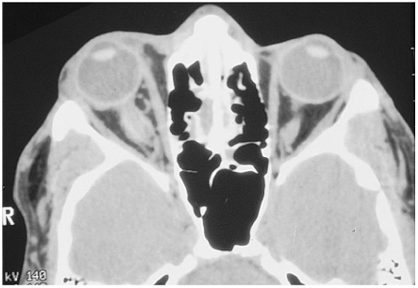 |
Figure 9.37. This patient poked himself in the right eye with a car antenna. Ptosis and rapidly progressive visual loss were experienced, and an entrance wound was found in the right upper lid. Axial computed tomography showed an enlarged optic nerve sheath consistent with optic nerve sheath hematoma. This was confirmed on surgical exploration. (Courtesy of John W. Shore, M.D., Boston, MA, and Jurij Bilyk, M.D., Philadelphia, PA.) |
In cases of indirect trauma to the intracanalicular portion of the nerve, the ophthalmoscopic examination is normal. Injury to the intracranial portion of the optic nerve is rare but has been associated with closed head trauma.
Management
Traumatic optic neuropathy is primarily a clinical diagnosis. However, CT imaging is extremely helpful in evaluating the status of the orbit, the optic nerve, and the integrity of the surrounding bony structure. MRI may add information after it has been determined that no metallic foreign body is present.
There is no specific treatment for direct injury to the optic nerve. Compression on the nerve by intraorbital hemorrhage is treated by orbital decompression, and hemorrhage within the nerve sheath may be helped by an optic nerve sheath fenestration procedure. Generally, intraorbital foreign
P.340
bodies should be removed, although some may be observed, depending on their composition and position in the orbit.
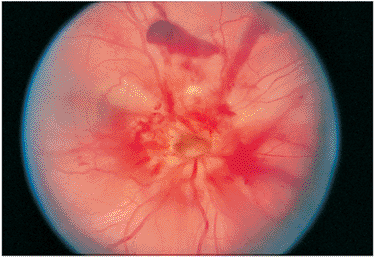 |
Figure 9.38. Avulsion of the optic nerve head, showing pit at the site of the papilla surrounded by a ring of hemorrhage. (Courtesy of William C. Benson, M.D., Philadelphia, PA.) |
Treatment of posterior indirect traumatic optic neuropathy involving the intracanalicular portion of the nerve remains controversial (Table 9.2). Some clinicians recommend high doses of intravenous corticosteroids within the first 24 hours of injury, continuing for 2 to 3 days. Although there is some evidence that corticosteroids are helpful in spinal cord injuries, the efficacy of this treatment in traumatic optic neuropathy remains unproven, and the complications associated with corticosteroid therapy must be kept in mind. Surgical depression of the optic canal is a treatment option in some cases but also remains controversial. The Traumatic Optic Neuropathy Treatment Trial is evaluating these treatment options.
Table 9.2. Treatment Recommendations for the Two Most Frequent Forms of Traumatic Optic Neuropathy | ||
|---|---|---|
|
Leber's Stellate Neuroretinitis
Leber's stellate neuroretinitis is the constellation of optic disc edema and a macular star due to any presumed or known inflammatory or infectious optic neuropathy. Cat-scratch disease caused by Rochalimaea (Bartonella) henselae, a gram-negative bacillus, is the most common infectious cause. Systemic symptoms are mild when present, but 50% of patients have a history of an antecedent viral infection. Ocular manifestations include Parinaud's oculoglandular syndrome, a unilateral granulomatous conjunctivitis with ipsilateral preauricular or submandibular lymphadenitis, uveitis, and retinal vasculitis. Diagnosis is facilitated by a history of a cat scratch combined with a high antibody (immunoglobulin G) titer to R. henselae in sera. The condition responds to several different antibiotics, including erythromycin, doxycycline, and ciprofloxacin (Fig 9.39). Other causes of neuroretinitis are idiopathic, viral (e.g., chickenpox, mumps, measles), spirochetal infections (secondary or tertiary syphilis), and Lyme disease (stage III).
Congenital Disc Anomalies
Pseudopapilledema
In patients with pseudopapilledema, the discs appear slightly elevated and the margins indistinct but without other signs of increased intracranial pressure.
Clinical Features
Normally optic discs are contiguous with the plane of the retina and possess a discernible optic cup. In some cases, discs may be elevated to simulate papilledema (Fig. 9.40). These discs do not have visible physiologic cups, and the large vessels appear to originate from the center of the discs. There are no dilated capillaries on the
P.341
disc surface, and the nerve fiber layer is clear, without the opacification typical of papilledema. Hemorrhages and exudates are rarely present. In a significant percentage of these discs, the fullness is the result of visible or buried drusen.
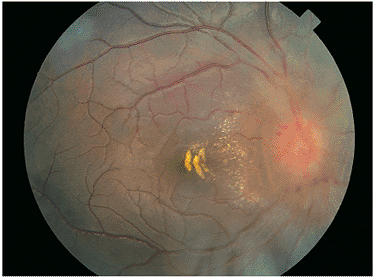 |
Figure 9.39. Neuroretinitis secondary to cat-scratch disease. The right optic disc is hyperemic and there is a macular star. |
 |
Figure 9.40. Pseudopapilledema. There is no cup in either nerve head, and the vessels egress from the center of the disc. There are no hemorrhages or exudates, and the nerve fiber layer is not opacified. The right disc (A) appears more elevated than the left (B). |
Management
Pseudopapilledema usually is diagnosed during a routine eye examination or may be noticed on fundus examination as part of a workup for other medical problems. Follow-up to document the relative static appearance of the discs is helpful.
Drusen of the Optic Disc
Small, yellow-white formations in the optic nerve head anterior to the lamina cribrosa are known as hyaline bodies or, more commonly, drusen.
Clinical Features
The disc may appear elevated, with blurred margins and lacks a physiologic cup. The drusen are yellowish white and vary in size (Fig. 9.41). Sometimes, they are seen best in reflected light by directing the ophthalmoscopic beam at the disc margin. Drusen are presumed to be an accumulation of axoplasmic debris. They are invisible (i.e., buried) in early childhood but become more prominent with age. They are bilateral in 66% of patients. Occasionally, optic nerve drusen may be associated with hemorrhages on the surface of the disc or in the peripapillary retinal or subretinal area (Fig. 9.42).
 |
Figure 9.41. Drusen are visible as round, crystalline formations. The discs have a typical yellowish hue, and there are no cups. A: Right eye. B: Left eye. |
The visual field defects are highly variable but usually affect the nerve fiber bundle and may be progressive. There is no known method of halting or preventing progressive visual field loss. Visual acuity is rarely decreased. There is no unequivocal association with any systemic or ocular disease.
Pits of the Optic Nerve
Optic pits are congenital defects most frequently located temporally and inferiorly at the disc margin.
Clinical Features
Pits are sharply outlined and a deeper gray color compared with the remainder of the disc surface. The amount of excavation and the size are variable. A small, cilioretinal artery sometimes can be seen exiting at the pit margin. There may be adjacent chorioretinal atrophy. Visual acuity is usually good, but visual field changes in the form of nerve fiber bundle or altitudinal defects may be found. Evidence of serous retinal detachment in the macular
P.342
area has been reported in 40% of eyes with congenital pits (Fig. 9.43). Chronic serous retinopathy may result in decreased vision. Fluorescein angiography is indicated if central serous retinopathy is suspected and cannot be confirmed by ophthalmoscopy alone.
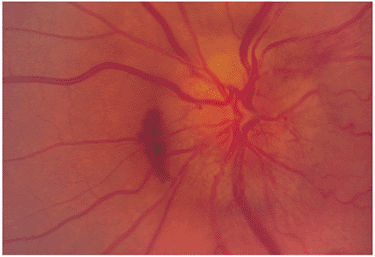 |
Figure 9.42. Right disc with visible drusen at the 11:30 position. Hemorrhages are seen on the disc surface and beneath the retinal pigment epithelium concentric to the disc. |
Coloboma of the Optic Nerve
A larger congenital excavation of the optic nerve head is known as a coloboma and is related to a faulty closure of the fetal fissure.
Clinical Features
The disc is enlarged and appears white and excavated, typically in the inferior portion. The size of the coloboma varies, sometimes occupying most of the disc (Fig. 9.44). The vessels are located near the disc margin. Contiguous chorioretinal coloboma and peripapillary chorioretinal atrophy are common features. Visual acuity is often reduced from 20/100 to hand motions. As with pits, serous retinal detachments develop in a high percentage of eyes with disc colobomas. Disc malformations may be associated with other facial and skull defects, including basal encephaloceles.
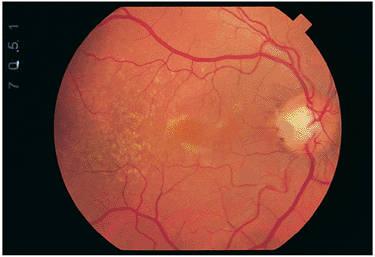 |
Figure 9.43. Typical edema residues in the macula of a patient with central serous chorioretinopathy associated with a pit of the right optic disc. |
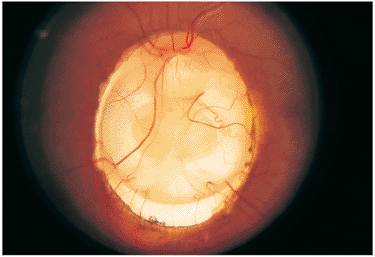 |
Figure 9.44. Large coloboma of the disc. This patient had a basal encephalocele due to a midline defect at the base of the skull. |
Morning Glory Disc
Morning glory disc is a congenital disc anomaly characterized by an enlarged, funnel-shaped disc with a central core of white tissue surrounded by chorioretinal pigmentary changes, resulting in the ophthalmoscopic resemblance to the flower (Fig. 9.45).
Clinical Features
The disc is pale and enlarged to the extent that the reflex within the papillary space may be mistaken for a leukokoria. This disc is excavated, and the vessels are located at the periphery. The condition is unilateral. Vision is considerably reduced to the extent that an RAPD may be found. The cause remains controversial.
Oblique Insertion of the Optic Nerve
Optic discs that obliquely insert into the eye appear tilted on ophthalmoscopy (Fig. 9.46). The tilt may occur in any direction and is usually associated with a crescent adjacent to the disc. The association of congenitally tilted optic disc with an inferonasal scleral crescent is known as the tilted disc syndrome. Ectasia of the nasal and inferior fundus is seen in a high percentage of these patients and may produce a temporal
P.343
visual field defect. However, some of the field defects in tilted disc syndrome are refractive scotomas, resulting from exaggerated astigmatism at an oblique axis, and they disappear with full lens correction.
 |
Figure 9.45. Morning glory disc. (Courtesy of Gary Brown, M.D., Philadelphia, PA.) |
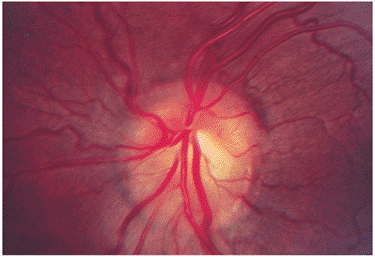 |
Figure 9.46. Tilted disc syndrome. The optic nerve appears to be tilted superiorly. |
Hypoplasia of the Optic Disc
A smaller than normal optic disc may be associated with delayed or incomplete physical growth, neuroendocrine disturbances, and central nervous system abnormalities.
Clinical Features
The disc is small, often pale, and may be surrounded by a yellow-white ring with variable pigmentation (Fig. 9.47). This appearance has been referred to as the double ring sign, with the peripheral margin of the encircling ring corresponding to the border of a normal-sized optic disc. The inner ring corresponds to the termination of the retina and retinal pigment epithelium. Vision may range from normal to the level of no light perception. Visual field defects are common but are not characteristic.
Hypoplasia of the optic disc has been associated with young maternal age, drug use during pregnancy, and maternal diabetes. Hypoplasia of the optic nerve may be associated with numerous and varied systemic developmental abnormalities. The association of an absence of the septum pellucidum, optic nerve hypoplasia, and pituitary dwarfism is known as septooptic dysplasia (de Morsier's syndrome).
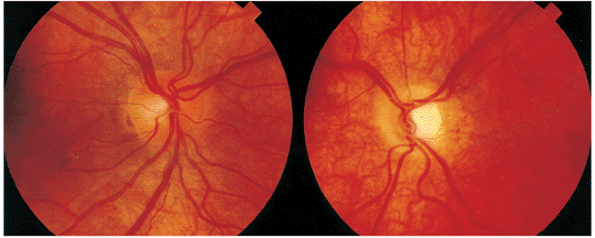 |
Figure 9.47. Hypoplasia of the optic nerve. The right optic disc is normal. A small nubbin of tissue is located nasally in the left disc. The rest of the disc is empty, and a typical double ring sign is seen, particularly nasally. The nerve fiber layer is practically nonexistent. |
Management
Children found to have decreased vision associated with hypoplasia of the optic nerve should have a trial of standard amblyopia therapy to determine if vision can be improved. Consultation with a pediatric endocrinologist is indicated to evaluate for growth and endocrine abnormalities.
Topless Optic Disc Syndrome
Topless optic disc syndrome or superior segmental optic hypoplasia is a congenital anomaly of the superior part of the disc. Patients usually have good visual acuity with an inferior altitudinal field defect. The disc appearance is characterized by pallor of the superior disc, a relative superior entrance of the central retinal artery, thinning of the superior peripapillary nerve fiber layer, and superior peripapillary scleral halo. It is most commonly seen in patients whose mothers had insulin-dependent diabetes (Fig 9.48).
Congenital Disc Sheathing
During embryonic development, glial cells surround the intravitreous hyaloid artery. This periarterial sheathing is known as Bergmeister's papilla. Late in fetal development, this papilla atrophies, and the degree to which it regresses determines in part the amount of physiologic cupping. However, if the regression is incomplete, residual amounts of glial tissue representing the former Bergmeister's papilla can be seen on the disc surface (Fig. 9.49). These formations also have been called prepapillary or congenital veils.
Patients with incomplete resolution of Bergmeister's papilla may present with a variety of other congenital optic disc abnormalities, including vascular loops, persistent hyperplastic primary vitreous, and morning glory disc anomaly.
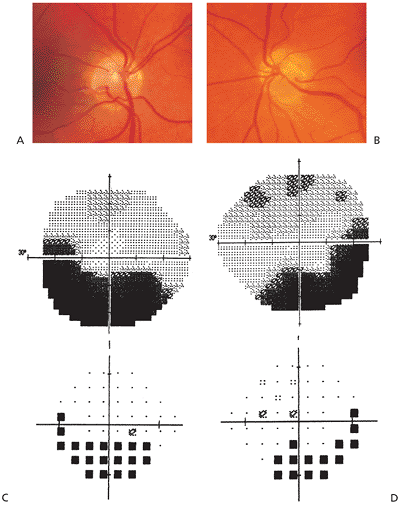 |
Figure 9.48. Topless disc syndrome (superior segmental optic disc hypoplasia). The optic disc is pale superiorly with a relative superior entrance of the central retinal artery, and superior peripapillary scleral halos. A: Right eye. B: Left eye. Humphrey automated perimetry shows bilateral inferior nerve fiber layer defects, worse in the left eye (C) than the right eye (D), corresponding to the optic nerve appearance. |
P.344
Persistent Hyaloid Artery
Occasionally, remnants of the primitive hyaloid artery are seen on the disc surface. The hyaloid artery enters the embryonic tissue at the 5-mm stage of development and reaches the posterior surface of the lens as part of the tunica vasculosa lentis. Regression of the hyaloid artery begins in the third month of gestation. Atrophy usually is complete by the eighth month, but portions of the artery may persist as atrophic, thread-like attachments or may be filled with blood (Fig. 9.50). The anterior attachment of the hyaloid artery to the posterior surface of the lens is known as a Mittendorf's dot, which persists as a small circular opacity in the inferior nasal aspect of the posterior lens capsule. Failure of the vascular system of the primary vitreous to regress leads to persistent hyperplastic primary vitreous.
Hereditary Optic Neuropathy
Leber's Hereditary Optic Neuropathy
Leber's hereditary optic neuropathy (LHON) is a hereditary syndrome characterized by bilateral visual loss, beginning in the second and third decades of life, and primarily affecting men.
Clinical Features
In the acute phase of the disease, there
P.345
is bilateral disc hyperemia and a characteristic peripapillary microangiopathy that may be present before visual symptoms are evident (Fig. 9.51). In the acute stage, the nerve fiber layer is opacified. As the acute phase recedes, the disc develops a pale, flat appearance. Vision is reduced to the range of 20/200 to finger counting.
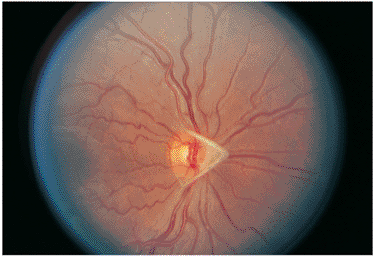 |
Figure 9.49. Bergmeister's papilla (i.e., congenital veil) is found typically on the nasal aspect of the disc. |
Most of those affected are men. LHON is transmitted through the female line, although only 14% of affected individuals are women. An unaffected carrier mother transmits the disease to 50% of her sons. It has been advanced that all daughters of carrier mothers become carriers themselves. Men cannot transmit the disease to their progeny. The disease may be associated with pathogenic mutations of mitochondrial DNA at various nucleotide positions. These mitochondrial defects affect other systems, including skeletal and cardiac muscle. Cardiac conduction defects may be encountered.
LHON may be mistaken for optic neuritis because of the age of onset and the signs of an acute unilateral optic neuropathy, including a swollen optic disc. However, rapid involvement of the fellow eye, the peripapillary telangiectasia, the family history, and the lack of recovery in most cases should strongly suggest LHON. Other forms of inherited optic atrophy may produce decreased vision and pale discs in the young, and these forms may be dominant or recessive. However, the hereditary optic atrophies are slowly progressive, without an acute phase.
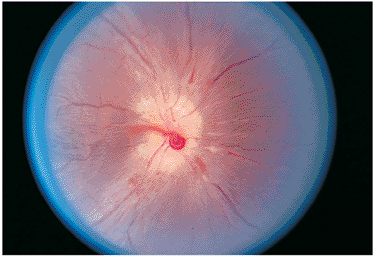 |
Figure 9.50. Blood-filled remnant of the hyaloid artery. |
Management
There is no treatment, although cases of spontaneous recovery to reasonable vision, even many years later, have been reported.
Dominant Optic Atrophy
Another optic nerve atrophy distinguishable from LHON is dominant optic atrophy. Visual acuity depression is mild in dominant optic atrophy.
Clinical Features
The onset of visual loss is insidious and occurs between 4 and 8 years of age. Vision is mildly to moderately depressed, usually in the range of 20/30 to 20/70. The condition is bilateral but may be asymmetric. Temporal pallor of the optic discs occurs (Fig. 9.52), dyschromatopsia may be present, and nystagmus has been reported in some pedigrees. Central scotomas are found on visual field examination. Vision remains stable in many cases, but a gradual decrease has been observed in others. Most patients do retain reasonably good visual function.
The Pupil
Innervation to the pupils is through the parasympathetic system, which produces pupillary constriction, and the sympathetic system, which produces pupillary dilation. A decrease in parasympathetic input produces pupillary mydriasis, and sympathetic lesions produce pupillary miosis. Because these abnormalities are usually unilateral, the presenting sign is anisocoria.
Anisocoria, a difference in size between the two pupils, is not necessarily a pathologic condition. It is estimated that approximately 20% of the normal population manifests clinically observable anisocoria (i.e., physiologic or simple anisocoria). The relative difference between pupillary size remains constant in dim and bright illumination in physiologic anisocoria. The degree of anisocoria due to sympathetic paresis is greater in dim illumination, and parasympathetic lesions produce anisocoria that is greater in bright light. Examination of the patient with anisocoria in different illumination levels is the first step in determining the cause of the pupillary disparity. Some pupillary abnormalities do not result in anisocoria but produce alterations in pupillary reactivity, shape, or position.
Pupillary reaction to light is decreased when a significant number of afferent visual fibers are not functioning, which may result from a disease process in the retina, optic nerve, optic chiasm, or optic tract. Lesions that destroy retinal function or involve the optic disc usually are visible with the ophthalmoscope, but for lesions of the retrobulbar optic nerve, the fundus examination initially may be normal. An abnormal pupil reaction to the swinging flashlight test is a relative afferent pupillary defect (Fig. 9.53). It provides objective evidence of anterior visual pathway dysfunction.
 |
Figure 9.51. Acute Leber's hereditary optic neuropathy (LHON) in a 20-year-old man who tested positive for the 11778 mutation. A: The right eye was involved first. The nasal portion of the disc shows nerve fiber layer opacification, and pallor is developing in the papillomacular area of the optic nerve head. B: Later, the left eye became involved, with opacification of nerve fiber layer. Retinal peripapillary telangiectasis, a typical finding in LHON, is evident. |
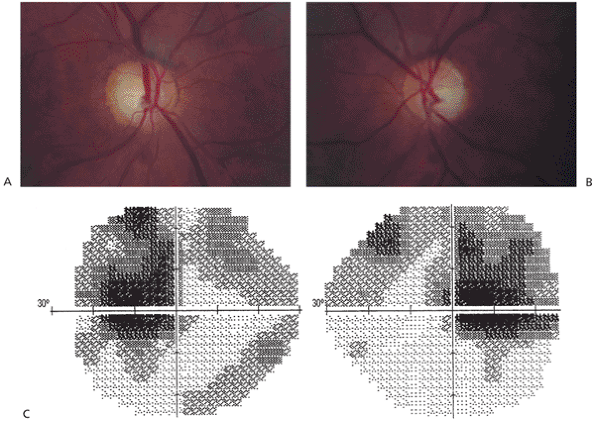 |
Figure 9.52. Dominant optic atrophy. Temporal pallor has occurred in the optic discs but has remained unchanged over 20 years of observation. A: Right eye. B: Left eye. C: Humphrey perimetry revealed typical pseudobitemporal hemianopia due to bilateral centrocecal scotomas. |
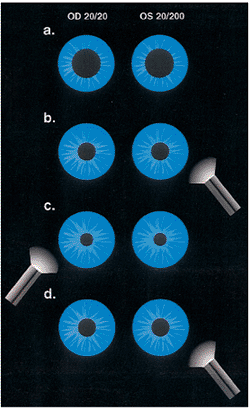 |
Figure 9.53. Relative afferent pupillary defect (RAPD). Vision in the right eye is 20/20, but vision in the left eye is 20/200 because of optic neuropathy. A: The pupils in dim light are equal. B: Light directed into the left eye results in a partial and sluggish contraction in each eye. C: Light directed into the right eye results in a brisk and normal reaction in each eye. D: The light quickly redirected into the left eye results in a dilatation of both pupils. It is possible to detect RAPD even in the presence of a dilated, dysfunctional pupil, as in a traumatic mydriasis or cranial nerve III palsy, by observing the other pupil. |
P.346
P.347
Dilated Abnormal Pupil
When the larger pupil is the abnormal one, the anisocoria is more prominent in bright light, because the pupil cannot constrict normally. This condition may have neurologic or nonneurologic causes.
Pharmacologic Blockade
The unilateral instillation of a pupil-dilating medication produces anisocoria. This may occur inadvertently or may be purposely done for some secondary gain. A frequent accidental dilation of the pupil is produced by scopolamine-impregnated patches that are placed behind the ear to prevent motion sickness. Direct instillation of scopolamine to the eye surface by the patient's contaminated finger causes the pupillary dilation (Fig. 9.54).
 |
Figure 9.54. Pharmacologic mydriasis. A: The right pupil is dilated and does not constrict in response to 1% pilocarpine. B: The patient placed a scopalamine-impregnated patch for motion sickness behind the right ear and subsequently rubbed his right eye. |
To detect pharmacologic blockade as the cause of pupillary dilation, 1% pilocarpine is instilled in both eyes. The pupil constricts unless it is pharmacologically dilated or there is structural iris damage, which is visible on biomicroscopy.
Trauma
Traumatic mydriasis may be seen with or without iris sphincter ruptures. A history of trauma usually is elicited, or sphincter abnormalities are detected on slit lamp examination (Fig. 9.55). Pupillary excursions may be diminished. With time, the pupillary dilatation may lessen.
Tonic or Adie's Pupil
The patient is usually asymptomatic or has vague complaints of blurred reading vision. The pupil is dilated, constricts minimally or not at all in response to direct light, but does constrict slowly to sustained near effort (Fig. 9.56). The redilation phase is equally slow and tonic. Biomicroscopy of the iris sphincter shows areas of sector paresis that result in a characteristic slow, vermiform constriction of the pupil in response to bright light.
This condition may be isolated to the pupil or may be associated with decreased deep tendon reflexes in the lower extremities (i.e., Adie's syndrome). Adie's pupil is thought to result from a lesion in the ciliary ganglion, where the accommodative fibers far outnumber the fibers for the pupillary light reflex. Regeneration restores some accommodative pupillary movement but little light reaction.
Denervation hypersensitivity is demonstrated by pupillary constriction to weak (0.1%) pilocarpine solution. The exact
P.348
cause of or time for development of this denervation hypersensitivity is unknown. Before denervation hypersensitivity occurs, the pupil may not constrict even in response to 1% pilocarpine, causing confusion with pharmacologic blockade.
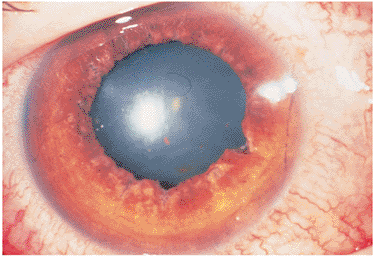 |
Figure 9.55. The right eye demonstrates iris sphincter tears from trauma induced by a bungee cord. (Photograph courtesy of John B. Jeffers, M.D., Philadelphia, PA.) |
Over time, the Adie's pupil tends to become bilateral, and affected pupils become more miotic.
Parasympathetic Paresis
Pupillary dilation due to a parasympathetic lesion usually does not occur without other signs of cranial nerve III involvement, such as associated ocular muscle paresis and ptosis.
A cranial nerve III palsy with pupillary dilation is a medical emergency. The patient must be investigated for a compressive lesion, especially a posterior communicating artery aneurysm. Other compressive lesions, such as pituitary tumors, may produce this syndrome. An MRI scan is required, and if no mass is detected, immediate arteriography is necessary to rule out a posterior communicating artery aneurysm. Although the resolution of MRI or CT angiography has improved, it has not eliminated the need for catheter angiography if MRI or CT is negative.
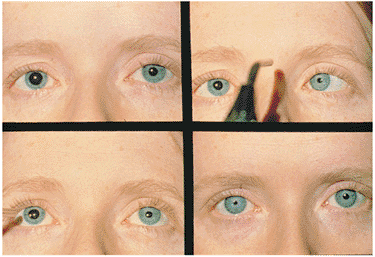 |
Figure 9.56. Adie's pupil. The right pupil (upper left) is dilated in standard light conditions, and it does not react to direct light (lower left) but does constrict slowly and tonically to near stimulus (upper right). Marked miosis develops after instillation of 0.1% pilocarpine (lower right). |
Dorsal Midbrain or Parinaud's Syndrome
Bilateral pupillary dilation with decreased reactivity to light but intact constriction to near effort (i.e., light near dissociation) is a hallmark of the dorsal midbrain syndrome. The pupils may also be eccentrically displaced, a condition called corectopia.
These patients are unable to look up voluntarily, and such an effort produces convergence retraction nystagmus (Fig. 9.57). Because this is a supranuclear disorder of upgaze, passive ductions (e.g., doll's head maneuver) produce more complete upgaze. Mass lesions in the pineal region are the most frequent cause of this syndrome, although nonmass lesions such as demyelinating disease and stroke can produce the dorsal midbrain syndrome.
Constricted Abnormal Pupils
Sympathetic Paresis or Horner's Syndrome
Sympathetic paresis of the eye produces ptosis because of decreased innervation of M ller's muscle and pupillary miosis (Fig. 9.58). Because the lower eyelid has an equivalent to
P.349
M ller's muscle (i.e., retractors of lower lid), the lower eyelid is higher on the side of the sympathetic paresis. Several inconsistent or transitory findings include decreased ipsilateral facial sweating, increased accommodation, and ocular hypotony. Iris heterochromia usually signifies congenital Horner's syndrome.
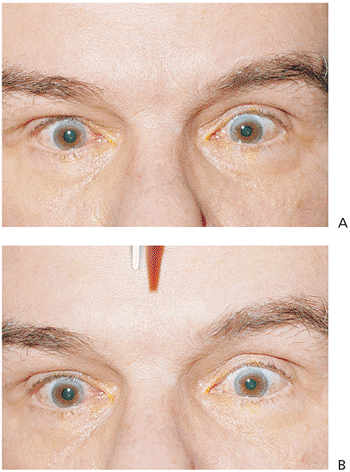 |
Figure 9.57. Dorsal midbrain syndrome (Parinaud's syndrome). The patient has (A) bilateral lid retraction, pupillary dilatation, and (B) the inability to look upward. The pupils do not react to light but do constrict to near effort. |
 |
Figure 9.58. Sympathetic paresis (Horner's syndrome). A 42-year-old woman presented with a droopy right upper eyelid and right-sided headache. A: The right upper lid is ptotic, and the lower lid is higher than the left. B: The anisocoria is greatest in dim light, indicating the right pupil is abnormal. C: The right pupil does not dilate with 1% hydroxyamphetamine (Paredrine), indicating a third-order Horner's syndrome. D: Magnetic resonance imaging revealed a white, semilunar image in the right carotid artery that was compatible with a carotid artery dissection (arrow). E: Magnetic resonance angiography confirmed the dissection (arrow). |
Horner's syndrome may occur with a lesion at any point along the three-neuron sympathetic chain. An isolated third-order Horner's syndrome is most likely to be caused by a benign condition and may be followed without investigation. Lesions of the first neuron usually produce other neurologic signs or symptoms, and second-order Horner's syndrome caused by superior pulmonary sulcus malignancies (i.e., Pancoast's syndrome) are accompanied by arm or scapular region pain.
The distinction between a preganglionic (i.e., first- and second-order Horner's syndrome) and a postganglionic (i.e., third-order Horner's syndrome) lesion can be made pharmacologically. Cocaine drops dilate normal pupils but not pupils with sympathetic paresis independent of the level of the lesion. Hydroxyamphetamine does not dilate the miotic pupil in Horner's disease if it results from a third-order neuron lesion but does dilate normal and first- and second-order Horner's pupils.
Management
The standard approach to investigating a patient with Horner's syndrome involves first pharmacologically confirming the diagnosis with topical cocaine (5% or 10%) and then localizing the lesion to the level of the neuron involved with hydroxyamphetamine 1%. An isolated postganglionic Horner's may be observed without investigation.
P.350
If carotid dissection is suspected, an arteriogram is performed. Preganglionic Horner's is investigated with imaging along the course of the sympathetic chain. Another approach is to not rely on the pharmacologic testing as hydroxyamphetamine is neither 100% sensitive nor specific and postganglionic Horner's is not always benign. In this approach, all Horner's patients undergo MRI of the head and chest and magnetic resonance angiography (MRA) of the neck. For Horner's with heterochromia, if there is no evidence of birth trauma, imaging should be done to exclude cervical or mediastinal tumors.
Argyll-Robertson Pupils
The Argyll-Robertson pupillary abnormality usually is due to syphilis. Patients have bilateral pupillary miosis and a poor light reaction, despite possessing normal vision, but they have a normal near response (i.e., light near dissociation).
Cranial Nerve Palsies
Cranial Nerve III Palsy
The third cranial nerve innervates the medial, inferior, and superior recti; the inferior oblique muscle, the levator palpebrae superioris, and it carries the parasympathetic fibers to the pupil. Signs of a cranial nerve III lesion are ptosis, decreased ocular elevation, depression and adduction, and occasionally, pupillary mydriasis.
Involvement of the third cranial nerve may represent a life-threatening situation. This condition, along with papilledema, is a true medical emergency.
Cranial nerve III arises in the midbrain from various subnuclear groupings. The lid and pupillary subnuclei are single-cell masses, and the subnuclei to the individual muscles innervated by cranial nerve III are paired. Another anatomic peculiarity of cranial nerve III is that the superior rectus fibers cross, with the right subnucleus giving rise to fibers innervating the left superior rectus and vice versa.
In the anterior cavernous sinus, cranial nerve III divides into a superior division, comprising lid and superior rectus fibers, and an inferior division, comprising medial and inferior rectus, inferior oblique muscles, and the parasympathetic pupillary fibers. However, partial, even divisional, involvement of cranial nerve III may occur at any point along its course.
Clinical Features
Cranial nerve III palsy produces ptosis and an inability to elevate, depress, or adduct the eye (Fig. 9.59). The pupil may be normal or dilated. Classically, isolated involvement of all portions of cranial nerve III without pupillary dilation is considered to be caused by infarction of cranial nerve III (i.e., vasculopathic mononeuropathy). Pupillary dilation, however, signifies a compressive lesion, and a posterior communicating artery aneurysm must be considered.
Management
Management of isolated cranial nerve III palsy in adults depends on whether the condition is total or partial and whether the pupil is normal or dilated.
For total palsy with a normal pupil, risk factors such as diabetes mellitus and hypertension in the appropriate age group (>45 years) should be identified. The patient can be observed and can expect recovery within 3 months. Neuroimaging is needed if the palsy progresses or other signs and symptoms occur. Patients between 10 and 40 years of age should have an MRI of the brain. If the results are normal, the patient should have a thorough medical evaluation and be observed closely. If the pupil becomes involved or signs and symptoms of subarachnoid hemorrhage develop, immediate arteriography is required.
For total palsy with a dilated pupil, the patient is admitted emergently. MRI is used to look for a compressive lesion, such as a pituitary tumor. If MRI is negative, arteriography is performed to search for a posterior communicating artery aneurysm.
For partial cranial nerve III paresis, the patient can be followed closely without treatment if the pupil is normal and the patient has risk factors that suggest a vasculopathic etiology. Alternatively, it is also reasonable to perform MRI followed by MRA if the MRI does not disclose a mass. Arteriography should be performed if symptoms or signs of an aneurysm develop. If the pupil is dilated, treatment is the same as for a patient with a total palsy and dilated pupil.
An isolated third cranial nerve palsy in younger patients may not be attributable to a vasculopathic process.
The suggested management of nontraumatic isolated cranial nerve III palsies in children follows:
Suspect ophthalmoplegic migraine in children.
Perform MRI for all children younger than 10 years of age, regardless of the state of the pupil. If the MR scan is negative, arteriography is not necessary because of the low likelihood of aneurysm.
Aberrant Regeneration
A peculiar ocular movement disorder may follow some cranial nerve III palsies (Fig. 9.60). This pattern is characterized by minimal or no ptosis in the primary position, eyelid elevation in attempted downgaze and adduction, restriction of vertical eye movements, and no pupillary constriction to light reflex but constriction on adduction. This pattern is seen most often after compressive III palsies, especially from posterior communicating artery aneurysms. It does not occur after vasculopathic III palsies.
The syndrome may be seen without a preceding apoplectic cranial nerve III palsy; this condition is called primary aberrant regeneration. This is an indication of a slowly growing mass lesion (e.g., meningioma, aneurysm) within the cavernous sinus.
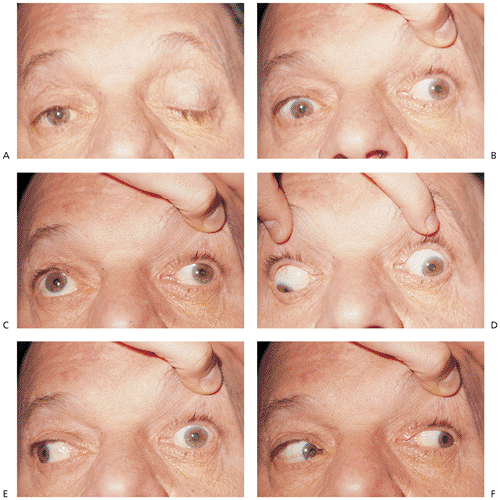 |
Figure 9.59. Third nerve palsy with relative pupil sparing. A: The patient has complete ptosis. B: In primary gaze, the affected left eye is deviated outwardly. The left pupil is only slightly larger than the right. The patient is unable to (C) elevate, (D) depress, or (E) adduct the eye. F: Abduction remains normal. |
P.351
Cranial Nerve IV Palsy
The trochlear cranial nerve is the only cranial nerve to cross to the opposite side (i.e., the right nucleus becomes the left nerve) and to exit the brainstem dorsally. Because of its long intracranial course and its anatomic relation to the anterior medullary velum and the tip of the temporal lobe, it is vulnerable to a variety of insults, especially trauma.
Clinical Features
Paresis or paralysis of the trochlear nerve produces a hypertropia that is worse on gaze to the opposite side and on head tilt to the same side (Fig. 9.61).
Trauma is the most frequent cause of cranial nerve IV paresis. A blow to the top of the head can produce bilateral fourth nerve palsies characterized by alternating hypertropias on right and left gaze and by ocular torsion that may be as large as 15 degrees to 20 degrees. Unilateral cranial nerve IV paresis has a torsional component, but it is usually less than 5 degrees of excyclotorsion.
Patients may have cranial nerve IV weakness resulting from a congenital or longstanding insult. These patients usually have intermittent diplopia, because they have developed the ability to fuse abnormally large amounts of vertical
P.352
P.353
ocular misalignment. The finding of a vertical fusional amplitude greater than 5 prism diopters usually indicates a congenital cranial nerve IV paresis.
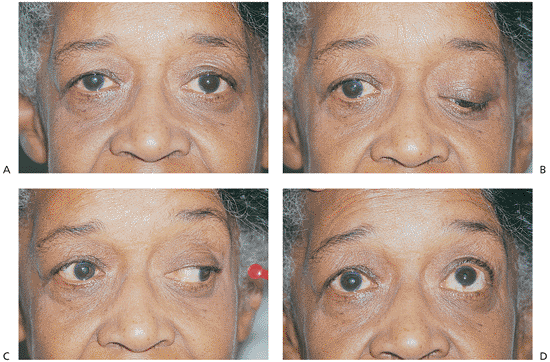 |
Figure 9.60. Aberrant regeneration after right cranial nerve III palsy. A: Four months after successful aneurysm surgery, there is minimal ptosis in primary gaze but retraction of the right upper lid develops on (B) downward and (C) left gaze. D: Superior gaze was also restricted. |
 |
Figure 9.61. The patient is an 11-year-old boy with right cranial nerve IV palsy who has a right hypertropia, which is worse on left gaze. He has no history of trauma. A: On right head tilt (top), the right eye elevates and the sclera below the inferior limbus is visible. On left head tilt (bottom), the patient is orthotopic. He has normal vertical fusional amplitudes. B: Magnetic resonance scan of the same patient shows a large lesion of the right temporal lobe, which was a malignant glioma. |
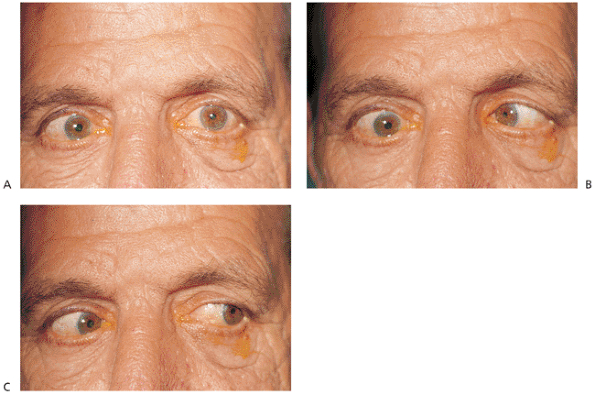 |
Figure 9.62. Right cranial nerve VI palsy. A: A right esotropia is demonstrated in the primary position. B: Right gaze reveals a complete abduction deficit. C: The patient was orthotopic on left gaze. |
Management
Patients of all ages with large vertical fusional amplitudes need no further evaluation. They have decompensating congenital fourth nerve palsies.
In the absence of trauma, cranial nerve IV palsies that are isolated usually are vasculopathic in origin in patients older than 45 years of age. Under these circumstances, imaging may be deferred as long as the typical clinical course of a vasculopathic mononeuropathy is obeyed: no other structures involved, no progression after 1 week, and resolution usually within 3 months. Imaging is performed when deviation from this course occurs.
For patients who are in the nonvasculopathic age group without large vertical fusional amplitudes and for any patient with a motility disorder that is not quite classic or who demonstrates extraocular muscle fatigue, myasthenia gravis should be excluded. If the results are normal, MRI can rule out a posterior fossa tumor.
Cranial Nerve VI Palsy
The abducens nerve is often involved by intracranial processes because of its long course.
Clinical Features
Diplopia is the presenting symptom. There is decreased abduction of the involved eye, resulting in horizontal diplopia that is greatest on gaze to the affected side (Fig. 9.62). Cranial nerve VI palsy in an older adult is usually of vasculopathic origin if the palsy is isolated. If other signs or symptoms are present, further investigation (usually imaging) is directed at finding an intracranial lesion.
Unilateral or bilateral palsies may be a nonlocalizing sign of increased intracranial pressure from any cause. Any patient with sixth nerve palsies must have a fundus examination to rule out the presence of papilledema.
Other causes of abduction defects include spasm of the near reflex (Fig. 9.63); orbital muscle inflammation, such as
P.354
Graves' ophthalmopathy (Fig. 9.64); Duane's retraction syndrome (Fig. 9.65); medial rectus entrapment in the medial orbital wall following trauma, orbital, or sinus surgery (Fig. 9.66); and myasthenia gravis.
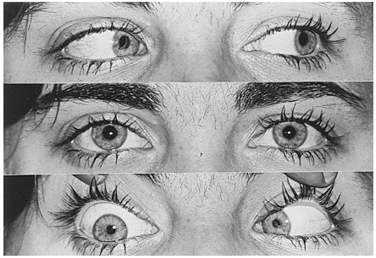 |
Figure 9.63. Spasm of the near reflex. The patient has a right abduction defect, but on right gaze (lower photo) the pupils are miotic compared with primary and left gazes. This indicates the patient is converging on attempted right gaze to simulate a right abduction defect. Pupillary miosis, which is part of the near triad along with convergence and accommodation, establishes the diagnosis. This complaint is usually nonphysiologic. |
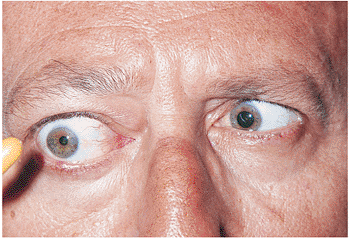 |
Figure 9.64. Restrictive myopathy. A right abduction defect is associated with right proptosis and lid retraction, unmistakable signs of thyroid-associated eye disease. |
Management
A patient with an isolated unilateral nontraumatic sixth cranial nerve palsy who is younger than 14 years of age does not require imaging, because the condition is probably benign, unless the patient develops additional signs or symptoms of neurologic disease or has no history of a recent flu-like episode or vaccination. The physician should discuss with the parents the possibility of a compressive lesion. If the parents are uncomfortable with not explicitly excluding the presence of a mass lesion, an MRI should be obtained.
 |
Figure 9.65. Duane's retraction syndrome. This child has bilateral abduction defects. A: A slight right esotropia is present in primary gaze. B: Right gaze shows a right abduction defect and narrowing of the left palpebral fissure. C: Left gaze shows similar defects. |
Patients between 15 and 40 years of age represent a controversial management problem. Although in many of these patients the problem is benign, MRI is indicated. If the scan is negative, a thorough medical and neurologic examination and other laboratory studies are indicated to exclude entities such as hypertension, collagen vascular disease, MS, Lyme disease, and syphilis.
Children with bilateral sixth nerve palsies and no history of head trauma may have raised intracranial pressure or meningeal-based disease. Thorough imaging studies constitute the first step in the investigation.
For any infant or child with an ocular motor paresis, the diagnosis of battered child syndrome must be considered. The physician should seek other signs of maltreatment, such as bruises, a basilar skull fracture, long bone fractures, and retinal hemorrhages.
Multiple Cranial Nerve Palsies
Patients with more than one cranial nerve involved simultaneously or with other signs or symptoms require a different approach. The most frequent clinical syndromes are those of the cavernous sinus, superior orbital fissure, and orbital apex (Fig. 9.67). The anterior border of the cavernous sinus is the superior orbital fissure. Immediately anterior to the superior
P.355
P.356
orbital fissure is the orbital apex. The cranial nerves in each area are listed in Table 9.3.
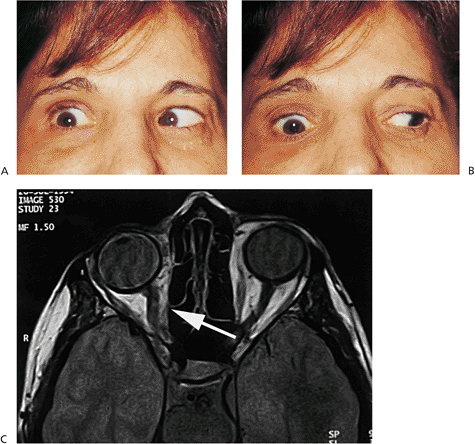 |
Figure 9.66. Medial rectus entrapment. This patient developed an abduction defect of the right eye after endoscopic sinus surgery. A: Right gaze shows a right abduction defect, and (B) left gaze demonstrates a restriction of the right medial rectus. C: Magnetic resonance reveals absence of the midportion of the right medial rectus muscle, with entrapment of the muscle stump and other tissue in the medial wall defect (arrow). A forced duction test was markedly positive laterally. |
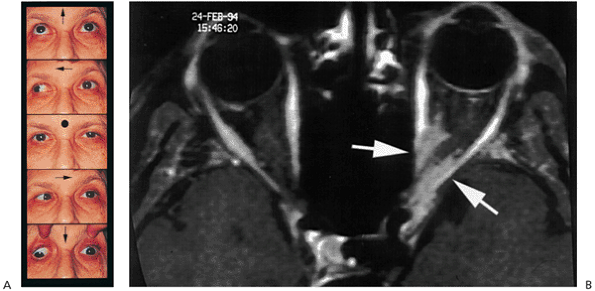 |
Figure 9.67. A 60-year-old woman with an inability to move the left eye and a swollen optic disc also had signs of an optic neuropathy. A: The eyes are orthotopic in primary gaze, although a left ptosis is evident. Right gaze reveals an adduction deficit in the left eye. In left gaze, the left eye cannot abduct, indicating multiple cranial nerve involvement. There is an inability to elevate and depress the left eye. B: Focused imaging revealed an enhancement at the orbital apex (arrows) that was later found to be lymphoma. |
Table 9.3. Location of Nerves Involved in Multiple Cranial Nerve Palsies | ||||||||
|---|---|---|---|---|---|---|---|---|
|
Clinical Features
Any combination of deficits of the nerves contained in the cavernous sinus or superior orbital fissure may be produced by a variety of lesions. Mass lesions such as pituitary tumors, cavernous sinus meningiomas, or aneurysms; inflammatory process such as Tolosa-Hunt syndrome; or infiltrative lesions such as lymphoma can look the same clinically. Differentiation requires imaging and a variety of other investigations.
Management
The first study to be performed in the diagnosis of any patient with an orbital apex, superior orbital fissure, or cavernous sinus syndrome is MRI with gadolinium enhancement. Treatment depends on the nature of the lesion found.
Cavernous Sinus Arteriovenous Fistula
An abnormal communication between the arterial and venous circulation in the region of the cavernous sinus produces symptoms that depend largely on the blood flow rate within the fistula.
Clinical Features
Chemosis and dilated (arterialized) conjunctival blood vessels are the hallmark of this disorder. Double vision is produced by cranial nerve III, IV, or VI palsies. Proptosis is prominent with high-flow fistulas. The intraocular pressure may be elevated because of increased episcleral venous pressure. An orbital bruit may be heard and the vision decreased from the effects of macular edema or ischemia.
 |
Figure 9.68. High-flow fistula. A: Ptosis and proptosis occurred in a 24-year-old woman after a car accident. B: Conjunctival chemosis, injection, and limitation of ocular movement are dramatic. |
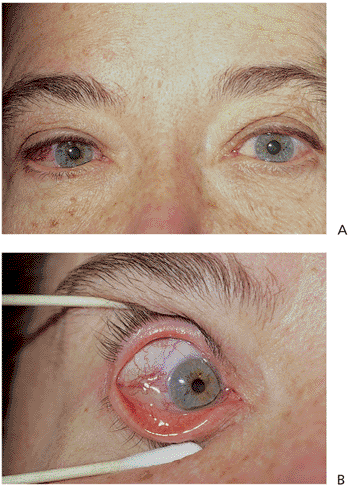 |
Figure 9.69. Low-flow fistula. A: The patient has right cranial nerve VI palsy with (B) arterialized conjunctival blood vessels. |
Trauma usually results in a high-flow fistula because of tears in the intracavernous portion of the carotid artery (Fig. 9.68). Low-flow fistulas, with appreciably muted symptoms, occur as a result of dural arteriovenous malformations (Fig. 9.69). Because fistulas are treatable with interventional neuroradiologic techniques, it is important to classify them according to their specific anatomy, as has been done by Barrow and colleagues (Table 9.4).
Detection of a fistula can be made by imaging the superior ophthalmic vein with ultrasound. Documentation of a
P.357
reversal of blood flow in the superior ophthalmic vein establishes the presence of a fistula (Fig. 9.70). Arteriography is required to determine the precise communications if closure of the fistula is to be attempted.
Table 9.4. Classification of Fistulas | ||||||||||||||||||||
|---|---|---|---|---|---|---|---|---|---|---|---|---|---|---|---|---|---|---|---|---|
| ||||||||||||||||||||
Management
For high-flow fistulas, arteriography is employed to determine the area of communication. Treatment is achieved with interventional neuroradiologic occlusion of the communication.
For low-flow fistulas, treatment is less urgent and may be delayed. Intermittent carotid massage may cause spontaneous closure of the fistula, with resolution of the signs and symptoms. Arteriography is required if interventional closure of the fistula is to be performed.
A patient's orbital signs may become worse, seemingly indicating increased flow within the fistula. However, spontaneous closure of fistulas may produce a paradoxical worsening of signs and symptoms. This can be demonstrated by color Doppler imaging, which shows decreased or no flow in the superior ophthalmic vein and not the increased flow expected. In this situation, observation of the patient is appropriate, anticipating eventual resolution of the orbital signs.
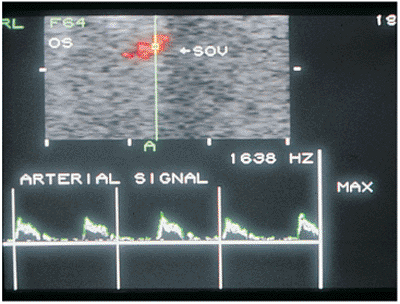 |
Figure 9.70. The color Doppler image reveals arterialized flow (red color) in the superior ophthalmic vein (SOV). Red color in the SOV indicates blood flow reversal from venous to arterial directions. Venous wave form (bottom) now has arterial spike characteristics. |
Chronic Progressive External Ophthalmoplegia
Chronic progressive external ophthalmoplegia (CPEO) is a form of mitochondrial myopathy. It may be associated with multisystem dysfunction.
Clinical Features
Isolated CPEO is characterized by slowly progressive bilateral ptosis and decreased excursions (i.e., loss of saccades) of the eye in all directions (Fig. 9.71). Patients do not complain of diplopia, because ocular involvement is symmetric. The major limitation in these patients is caused by ptosis and not by the ophthalmoplegia. Lid elevation surgery should be undertaken cautiously because patients have no vertical eye movement (including Bell's phenomenon) and may suffer corneal exposure and decompensation after surgery.
Kearns-Sayre syndrome is a particular form of CPEO that occurs in children and is associated with peripheral retinal pigment alternation (Fig. 9.72) and heart block. The latter
P.358
P.359
condition may be fatal unless the syndrome is recognized and a cardiac pacemaker inserted.
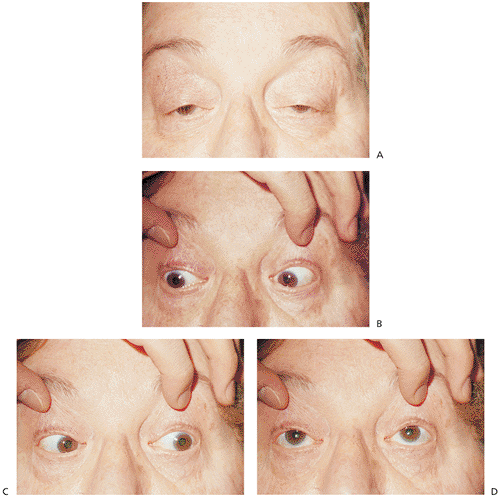 |
Figure 9.71. Chronic progressive external ophthalmoplegia. A 68-year-old woman had marked bilateral ptosis and limited excursions of eye movements in all directions: (A) straight forward gaze, (B) right gaze, (C) left gaze, and (D) upgaze. Saccades were markedly slowed. |
 |
Figure 9.72. In the fundus of a 13-year-old girl with Kearns-Sayre syndrome, the typical pigmentary disturbances involve the (A) macula and (B) retinal periphery. |
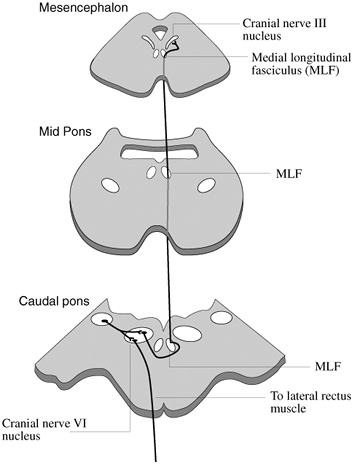 |
Figure 9.73. Schematic diagram of the median longitudinal fasciculus (MLF) nerve fiber tract. The MLF begins in the left sixth cranial nerve nucleus and immediately crosses to the opposite side of the brainstem to ascend to the third nerve nucleus contralateral to the sixth nerve nucleus of origin. (Illustration courtesy of Neal H. Atebara, M.D.; adapted from Burde RM, Savino PJ, Trobe JD. Clinical decision in neuro-ophthalmology. 2nd ed. St. Louis: Mosby Year Book; 1992:202, with permission.) |
These patients may also have a variety of other problems, such as short stature that causes them to appear much younger than their age, increased CSF protein levels, cerebellar abnormalities, and electrolyte imbalances. These patients usually die in the second or third decade of life. There is no treatment.
Progressive Supranuclear Palsy
This disorder of ocular motility may resemble CPEO. However, progressive supranuclear palsy affects downgaze first, is associated with neck and truncal rigidity, and shows increased eye movement with a doll's head maneuver or caloric stimulation, indicating the supranuclear nature of the syndrome. The palsy is seen in patients in their sixth or seventh decade. These patients develop dementia and usually die of intercurrent pulmonary events. There is no effective treatment.
Internuclear Ophthalmoplegia
The medial longitudinal fasciculus (MLF) is a nerve fiber tract in the brainstem that connects the sixth nerve nucleus with the contralateral third nerve nucleus, allowing conjugate eye movements to the right and left to be performed. The MLF arises in the sixth nerve nucleus, and the fibers almost immediately cross to the opposite side of the brainstem. They ascend from the pons to the midbrain, where they join the medial rectus subnuclei of the contralateral third nerve nucleus (Fig. 9.73). A lesion in the MLF produces a characteristic eye movement disorder called an internuclear ophthalmoplegia (INO).
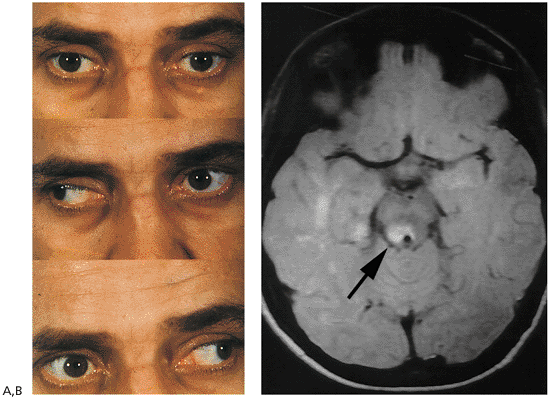 |
Figure 9.74. A: The patient has bilateral adduction deficits, but the eyes are straight in primary position (top). B: The magnetic resonance scan shows a demyelinating plaque that crosses the midline at the brainstem, accounting for bilateral median longitudinal fasciculus lesions. |
Clinical Features
In its total form, the eye movement disorder is characterized by what appears to be an isolated medial rectus weakness ipsilateral to the side of the MLF lesion (e.g., a right adduction deficit is a right MLF lesion and a right INO). There is often an abducting nystagmus of the contralateral eye on gaze away from the affected side of the brainstem.
Patients often do not complain of double vision but complain of a strange visual phenomenon or of something being wrong with their vision.
In the case of complete INO, the adduction deficit is total, with the eye not moving inward past the midline. If the INO is incomplete (i.e., an ophthalmoparesis and not an ophthalmoplegia), the only abnormality may be a partial adduction deficit or no adduction deficit but a lag in the speed of the adducting saccade. This can be brought out in all forms of INO by having the patient look from extreme abduction quickly to the midline and documenting a saccadic float in the affected eye.
Any lesion involving the MLF may produce an INO. The most frequent causes of this disorder are MS and brainstem stroke. MS occurs mostly in young people, and the INO tends to be bilateral (Fig. 9.74). The INO from stroke usually occurs in older people and tends to be unilateral.
Management
Any patient who presents with an INO
P.360
should have MRI of the brainstem performed. An INO represents intrinsic brainstem disease. The failure to image a lesion in the brainstem should not dissuade the examiner from making the diagnosis, because lesions in this area often are not seen, particularly if the imaging is less than ideal.
 |
Figure 9.75. Myasthenia gravis. Slight right ptosis on initial upward gaze (A), which increases after 1 minute (B). |
Myasthenia Gravis
Myasthenia gravis is an autoimmune disorder resulting in a decreased number of acetylcholine receptors at neuromuscular junctions.
Clinical Features
A drooping eyelid or double vision may be the initial ocular symptom of myasthenia gravis. Unilateral or bilateral ptosis, with or without other ocular signs, occurs as the initial manifestation of myasthenia in as many as 75% of patients. Myasthenic ptosis is absent or minimal on awakening but becomes more pronounced during waking hours. This fatigability may be demonstrated by having the patient look upward and waiting for increased ptosis to be exhibited (Fig. 9.75).
The hallmarks of myasthenic ptosis are variability, fatigability, and periods of exacerbation and remission. Ocular motility disorders may accompany the lid signs of myasthenia. Myasthenic ocular misalignment may simulate any pattern of neuro-ophthalmic strabismus.
 |
Figure 9.76. Patient with left ptosis (A), which resolves on injection of intravenous edrophonium chloride (Tensilon) (B). |
Myasthenia gravis can be diagnosed by a variety of tests. The demonstration of elevated acetylcholine receptor antibodies establishes the diagnosis of myasthenia. Unfortunately, this test is positive for only 50% of patients with ocular myasthenia.
The Tensilon test consists of injecting up to 10 mg edrophonium chloride intravenously in divided doses and detecting improvement of ptosis. An unequivocal resolution of the ptosis is compelling evidence for myasthenia, although false-negative results occur (Fig. 9.76). False-positive test results are encountered more rarely. The ice test involves placing ice on a ptotic lid for 2 minutes. A 2-mm or greater improvement in ptosis has a 90% sensitivity and a 100% specificity for myasthenia gravis. Single fiber electromyography is positive in 88% to 92% of patients with ocular myasthenia (Fig 9.77).
Management
All newly diagnosed myasthenics must have chest imaging to search for thymic hyperplasia or thymoma and have thyroid function studies. The management of the disease is best left to neurologists or neuro-ophthalmologists.
 |
Figure 9.77. Patient with left ptosis (A), which resolves after application of ice for 2 minutes (B). |
P.361
Eyelid Abnormalities
Lid Retraction
Lid retraction is present if the sclera is visible between the superior limbus and the upper lid. The most common cause of lid retraction is Graves' orbitopathy (Fig 9.78). Other causes of lid retraction include scarring following inflammation, dorsal midbrain syndrome, sympathetic irritation (Claude Bernard syndrome), metabolic disorders (e.g., cirrhosis), and volitional lid retraction.
Ptosis
A drooping eyelid may have neurogenic, muscular, or congenital causes and may be associated with several syndromes.
Clinical Features
All drooping of the upper eyelid is not true ptosis. Other causes include blepharospasm, apraxia of lid opening, and pseudoptosis from ocular misalignment. Other conditions involving the eyelid, such as chalazia, tumors, and preseptal cellulitis, may cause a ptotic lid.
Evaluation of the patient with ptosis should first determine if the condition is congenital or acquired. Old photographs are helpful in this regard. If acquired, a neuro-ophthalmologic problem must be sought before the diagnosis of levator dehiscence is made. The most important neuro-ophthalmic entities are Horner's syndrome, cranial nerve III palsy, and myasthenia gravis.
 |
Figure 9.78. Lid retraction of the left eye in a 50-year-old woman with Graves' orbitopathy. A: Primary position. B: Lid retraction is still present in downgaze. |
Less frequently encountered causes of ptosis are Fisher's variant of the Guillain-Barr syndrome, botulism, and CPEO.
Essential Blepharospasm
Essential blepharospasm consists of bilateral, intermittent, uncontrollable spasm of the eyelids. The cause of essential blepharospasm is unknown.
Clinical Features
The clinical picture usually begins with frequent blinking but can progress until the patient must manually elevate one lid to see. This disorder is classified among the dystonias. It may be isolated, but if accompanied by other oral or facial movements, it is called Meige's syndrome.
Management
Medical treatment has been notoriously unsuccessful in treating blepharospasm. The first-line treatment consists of injection of botulinum toxin into the spastic orbicularis muscles. If the injections fail to relieve the symptoms, a variety of surgical options are available.
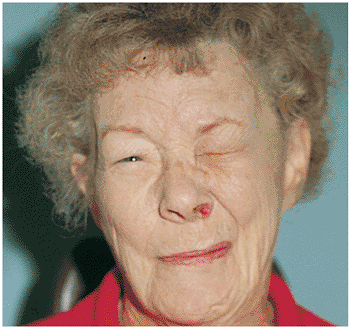 |
Figure 9.79. Hemifacial spasm in a 68-year-old woman. The condition is relieved for a period of months by botulinum injection. |
P.362
Hemifacial Spasm
In this condition, sporadic, uncontrolled spasms occur on one side of the face.
Clinical Features
Hemifacial spasm presents initially as myokymic movements of the lower eyelid. When the disorder is fully developed, patients manifest unilateral spasm of one side of the face (Fig. 9.79). The spasm occurs unexpectedly, without an apparent precipitating cause. It lasts for seconds and then disappears. In the quiet phase, patients frequently show subtle signs of ipsilateral cranial nerve VII nerve weakness.
The likely causes are idiopathic or secondary to compression of cranial nerve VII by an aberrant loop of artery. Less frequent causes are MS and cerebellopontine angle tumors.
Management
The preferred treatment for hemifacial spasm is local injection of botulinum toxin.
Bibliography
Adler CH, Zimmerman RA, Savino PJ, et al. Hemifacial spasm: evaluation by magnetic resonance imaging and magnetic resonance tomographic angiography. Ann Neurol 1992;32:502.
Anderson RL, Patrinely JR. Surgical management of blepharospasm. Adv Neurol 1988;49:501.
Barrow DL, Spector RH, Brown IF, et al. Classification and treatment of spontaneous carotid-cavernous sinus fistulas. J Neurosurg 1985;62:248.
Beck RW, Cleary PA, Anderson MM, et al. A randomized, controlled trial of corticosteroids in the treatment of acute optic neuritis. N Engl J Med 1992;326:581.
Beck RW, Cleary PA, Trobe JD, et al. The effect of corticosteroids for acute optic neuritis on the subsequent development of multiple sclerosis. N Engl J Med 1993;329:1764.
Beck RW, Cleary PA, and the Optic Neuritis Study Group. Optic Neuritis Treatment Trial: one-year follow-up results. Arch Ophthalmol 1993;111:773.
Beck RW, Savino PJ, Repka MX, et al. Optic disc structure in anterior ischemic optic neuropathy. Ophthalmology 1984;91:1334.
Beck RW, Savino PJ, Schatz NJ, et al. Anterior ischemic optic neuropathy: recurrent episodes in the same eye. Br J Ophthalmol 1983;67:705.
Beck RW, the Optic Neuritis Study Group. The Optic Neuritis Treatment Trial: three-year follow-up results. Arch Ophthalmol 1995;113:137.
Bilyk JR, Joseph MP. Traumatic optic neuropathy. Semin Ophthalmol 1994;9:200.
Boghen DR, Glaser JS. Ischaemic optic neuropathy. The clinical profile and history. Brain 1975;98:689.
Brown GB, Tasman W. Congenital anomalies of the optic disc. New York: Grune & Stratton; 1983:157.
Burde RM, Savino PJ, Trobe JD. Clinical decisions in neuro-ophthalmology. 2nd ed. St. Louis: CV Mosby; 1992:200.
Drachman DB. Myasthenia gravis. N Engl J Med 1994;330:1797.
Francis DA, Compston DA, Batchelor JR, et al. A reassessment of the risk of multiple sclerosis developing in patients with optic neuritis after extended follow up. J Neurol Neurosurg Psychiatry 1987;50:758.
Glaser JS. Topical diagnosis: prechiasmal visual pathways. In: Tasman W, Jaeger EA. Duane's clinical ophthalmology, vol 2. Philadelphia: JB Lippincott; 1994:7.
Hashimoto M, Ohtsuka K, Nakagawa T. Topless optic disk syndrome without maternal diabetes mellitus. Am J Ophthalmol 1999;128:111.
Horton JC. Wilbrand's knee of the primate optic chiasm is an artefact of monocular enucleation. Trans Am Ophthalmol Soc 1997;95:580.
Hoyt WF, Luis O. The primate chiasm. Arch Ophthalmol 1963;70:69.
Jacobson DM, Trobe JD. The emerging role of magnetic resonance angiography in the management of patients with third cranial nerve palsy. Am J Ophthalmol 1999;128:94.
Johns DR, Smith KH, Savino PJ, et al. Leber's hereditary optic neuropathy: clinical manifestations of the 15257 mutation. Ophthalmology 1993;100:981.
Kearns TP, Sayre GP. Retinitis pigmentosa, external ophthalmoplegia, and complete heart block; unusual syndrome with histologic study in one of two cases. Arch Ophthalmol 1958;60:280.
Keltner JL, Johnson CA, Spurr JO, et al. Visual field profile of optic neuritis: one year follow-up in the Optic Neuritis Treatment Trial. Arch Ophthalmol 1994;112:946.
Kissel JT, Burde RM, Klingele TG, et al. Pupil-sparing oculomotor palsies with internal carotid posterior communicating artery aneurysm. Ann Neurol 1983;13:149.
Ksiazek SM, Repka MX, Maguire A, et al. Divisional oculomotor nerve paresis caused by intrinsic brain stem disease. Ann Neurol 1989;26:714.
Lam BL, Thompson HS, Corbett JJ. The prevalence of simple anisocoria. Am J Ophthalmol 1987;104:69.
Macaluso DC, Shultz WT, Fraunfelder FT. Features of amiodarone-induced optic neuropathy. Am J Ophthalmol 1999;127:610.
Moraes CT, DiMauro S, Zeviani M, et al. Mitochondrial DNA deletions in progressive external ophthalmoplegia and Kearns-Sayre syndrome. N Engl J Med 1989;320:1293.
Morrissey SP, Miller DH, Kendall BE, et al. The significance of brain magnetic resonance imaging abnormalities at presentation with clinically isolated syndromes suggestive of multiple sclerosis: a 5-year follow-up study. Brain 1993;116:135.
Optic Neuritis Study Group. The 5-year risk of MS after optic neuritis: experience of the Optic Neuritis Treatment Trial. Neurology 1997;49:1404.
Rivero A, Crovetto L, Lopez L, et al. Single fiber electromyography of extraocular muscles: a sensitive method for the diagnosis of ocular myasthenia gravis. Muscle Nerve 1995;18:943.
Regillo CD, Brown GC, Savino PJ, et al. Diabetic papillopathy: patient characteristics and fundus findings. Arch Ophthalmol 1995;113:889.
P.363
Rosenberg MA, Savino PJ, Glaser JS. A clinical analysis of pseudopapilledema. I. Population, laterality, acuity, refractive error, ophthalmoscopic characteristics, and coincident disease. Arch Ophthalmol 1979;97:65.
Savino PJ, Maus M. Botulinum toxin therapy. In: Breen LA. Neurologic clinics. Philadelphia: WB Saunders; 1991:205.
Savino PJ, Paris M, Schatz NJ, et al. Optic tract syndrome: a review of 21 patients. Arch Ophthalmol 1978;96:656.
Savino PJ, Sergott RC, Bosley TM, Schatz NJ. Hemifacial spasm treated with botulinum A toxin injection. Arch Ophthalmol 1985;103:1305.
Schatz NJ, Savino PJ, Corbett JJ. Primary aberrant oculomotor regeneration. A sign of intracavernous meningioma. Arch Neurol 1977;34:29.
Sergott RC, Cohen MS, Bosley TM, et al. Optic nerve decompression may improve the progressive form of non-arteritic ischemic optic neuropathy. Arch Ophthalmol 1989;107:1743.
Sergott RC, Grossman RI, Savino PJ, et al. The syndrome of paradoxical worsening of dural cavernous sinus arteriovenous malformations. Ophthalmology 1986;94:205.
Steinsapir KD, Goldberg RA. Traumatic optic neuropathy. Surv Ophthalmol 1994;38:487.
Thompson HS. A classification of tonic pupils. In: Thompson HS, Daroff R, Frisen L, et al. Topics in neuro-ophthalmology. Baltimore: Williams & Wilkins; 1979:95.
Van der Weil HL, Van Gijn J. Localization of Horner's syndrome: use and limitations of the hydroxyamphetamine test. J Neurol Sci 1983;59:229.
Vincent A, Newsom-Davis J. Acetylcholine receptor antibody as a diagnostic test for myasthenia gravis: results in 153 validated cases and 2067 diagnostic assays. J Neurol Neurosurg Psychiatry 1985;48:1246.
Wallace DC, Singh G, Lott MR, et al. Mitochondrial DNA mutation associated with Leber's hereditary optic neuropathy. Science 1988;242:1427.
EAN: 2147483647
Pages: 17